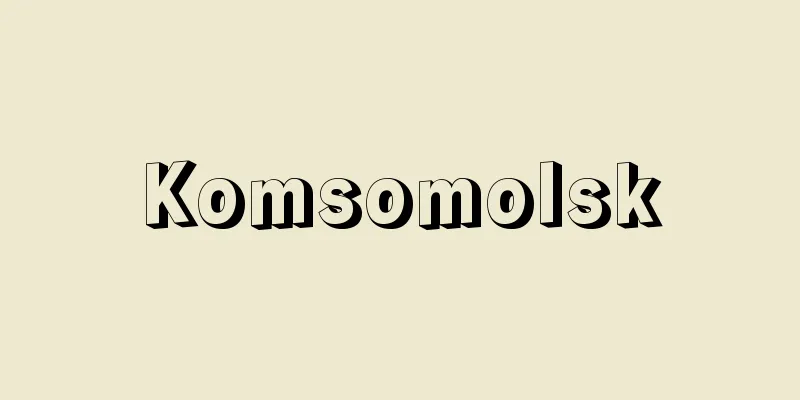Hungary - Hungary (English spelling)

|
A republic located in the middle reaches of the Danube River in Central Europe. Its official name in Hungarian (Magyar) is Magyarország. In English, it is called Hungary. It is a landlocked country founded by the Magyars, a Finno-Ugric people of Asiatic origin, surrounded by Austria, Slovakia, Ukraine, Romania, Serbia, Croatia, and Slovenia. Its area is 93,028 square kilometers, and its population is 10,071,000 (2006), 9,960,000 (2012). Its capital is Budapest. The national flag is a red, white, and green tricolor, representing revolution, peace, and hope. The national anthem is "Hymnusz". [Kazuo Furukawa] Nature and GeographyHungary occupies a major part of a large tectonic basin surrounded by the Alps, Carpathians, Transylvanian Alps, and Dinaric Alps, which were formed in the Tertiary Period of the Cenozoic Era. Approximately 60% of the country is low-lying land with an altitude of less than 200 meters. The Danube River runs through almost the center of the country from north to south. The country can be broadly divided into five topographical regions based on its topographical characteristics: (1) the Hungarian Backbone Mountains (also called the Central Mountains or the Northern Central Mountains), (2) the Small Plain (Kis-Orfeld), (3) the Great Plain (Nagy-Orfeld), (4) the Trans-Danubian (Dunan-Tur) Plateau, and (5) the Meček Mountains. [Kazuo Furukawa] Mountain backboneThe mountain range is tectonically continuous as one branch of a series of folded mountains formed in the Tertiary Period, but it was later divided by fault movements accompanied by local volcanic activity, forming many landslide mountains. The Danube River is also considered to be a leading valley that runs across the mountain range. On the west bank of the Danube River, that is, on the Trans-Danubian Plateau side, various mountain ranges of different sizes, such as Bacony, Geleč, Piriš, Visegrad, and Buda, stretch from the eastern foot of the Alps to the banks of the Danube River. Of these, the Bacony Mountains are the largest and are covered with beautiful forests, and the surrounding areas are rich in bauxite. On the southern edge of the Bacony Mountains lies Lake Balaton (area 596 square kilometers), the largest in Eastern Europe, which was formed by fault movements. From the lake shore, one can see the Badacsony mountain, made of basalt, a rare rock in Europe, similar to Japan's Yashima Island, and its foothills are known as one of the famous wine-producing regions. This mountain range extends further eastward to the Danube River, forming the mountain ranges of Bérsony, Czerhat, Matra, Bükk, and Zémplén. Mount Kékes (1,015 meters) in the Matra Mountains is the highest peak in Hungary, and the surrounding area is a coal and lignite producing region, and also produces iron ore on a small scale. Its center, Miskolc, is an industrial city with the third largest population in Hungary. The Bükk Mountains are made of calcareous rocks, and the dolomite region in the north is home to the Aggtelek caves, one of the largest in the world, making it a tourist and health resort. [Kazuo Furukawa] The Little and the Great PlainsThe Great Plain is a structural basin surrounded by the Alps, the Carpathian Mountains, and the mountain ranges. It occupies the western bank of the Danube, and the rivers Rava and Rabka, which originate in the Alps, flow east through this region, while the northern bank of the Danube is Slovakian territory. Most of the Great Plain belongs to the low-lying Tisza River basin, forming a vast plain. From the outside, it looks like a simple flat land with homogeneous soil, but throughout the long geological era, the Tisza River and its tributary, the Kerez River, have often flooded and changed their course, forming complex soil layers such as sandy soil elevations on natural levees and low marshes on old river channels. Furthermore, the formation of sand-drifting areas and sand dunes caused by wind action complicates the soil hydrological conditions despite the flatness. Nirshog in the north is rich in loess and sandy soil, and produces high-quality potatoes, corn, tobacco, etc. In the central region between the Danube and Tisza rivers, a series of sand dunes running northwest-southeast has developed, and in the well-drained sandy soil area, fruit cultivation such as grapes, apricots, strawberries, and peppers and horticulture are actively carried out, with Kecskemét being the center of such agriculture. In the lower reaches of the Keres River east of the Tisza River, the groundwater level is relatively high, but the amount of evapotranspiration is large compared to the amount of precipitation, so salt easily accumulates and the soil is alkaline in many places. As a result, the development of arable land has been restricted, and naturally occurring grasslands have been used as pastures since ancient times, and livestock farming has been thriving. Such steppe-like grasslands were called pusta, but after World War II, the construction of dams in the upper reaches of the Tisza River to generate electricity and secure irrigation water, and the construction of drainage facilities in the lower reaches led to the pusta gradually being converted into cultivated land. One example is the construction of the Tiszalik Dam and irrigation canal on the Tisza River south of Tokaj, a region famous for its grapes, as part of the First Five-Year Plan after the war. [Kazuo Furukawa] Trans-Danubian PlateauThe vast plateau covered with loess gradually rises in elevation as it heads west, continuing to the foothills of the Alps. Many rivers cut through this plateau and flow eastward, and the groundwater level is low, 20 to 30 meters below the surface, making it a water-scarce region susceptible to drought damage during droughts. [Kazuo Furukawa] Mechek MountainsThe mountain range is isolated in the southern part of the Trans-Danubian Plateau, but it is made up of granite and is tectonically connected to the Dinaric Alps. The Komlo and Pécs coalfields, which are small but produce the best coal in Hungary, are located nearby. The Danube River, which runs through the country, is the largest international river in central and eastern Europe, and although its value has declined due to the development of air routes, it remains an important trade route today. Budapest is one of the important international river ports, and information on the state of the Danube is sent to the ports along the river every day. In the south, there is the steelworks city of Dunouyváros, which was newly established after the Second World War. Most of Hungary has a continental climate, but the southwestern mountainous region is slightly influenced by the maritime climate. The average annual temperature in Budapest is 10.6 °C, the average annual precipitation is 508.2 mm, and the average annual humidity is 72.6%. [Kazuo Furukawa] historyNational unityThe Magyars left their cradle in the Urals in the 10th century BC, and after repeated contact with various Turkic peoples, invaded the Carpathian Basin in 895 AD. Seven Magyar tribes established a united state in this area and maintained a dual chiefdom for a while. However, their lifestyle gradually changed from a nomadic, horse-riding life to a settled, agricultural life, and the clan-based ruling system also began to crumble. At the end of the 10th century, the country was unified by father and son King Geza and Stephen I (reigned 1000-1038), and the first dynasty, the Árpád dynasty, was established. At the same time, the country was increasingly converted to Christianity, and in 1000 Stephen was given the title of king by the Pope. Under Stephen's rule, a royal palace system was established, and the beginnings of the formation of a feudal lord-vassal relationship were also seen. However, after his death, the ruling system was shaken by pagan rebellions and the rise of local lords within the country, and external conflicts with Rome and the Byzantine Empire over the Balkans and other areas. [Ieda Osamu] An era of rival warlordsFrom the end of the 12th century, the royal lands were broken up and the powerful clans divided their territories. In 1222, the king issued the Golden Charter, which recognized the privileges of the nobles in opposition to the powerful clans. After the Mongol invasion in 1241, Béla IV (reigned 1235-1270) tried to rebuild the country by colonizing various ethnic groups, and by the end of the 13th century, peasants had gained freedom of movement. However, these new conditions favored the powerful clans, and an era of rivalry began. The division of the country into fiefdoms was avoided by an alliance between the king and small lords and nobles, but the trend toward decentralization continued, and this time conflicts between the powerful nobles and the small and medium-sized nobles came to the surface. From the mid-14th century onwards, the territory expanded externally, but domestically the powerful nobles continued to grow, and in the first half of the 15th century, 40% of the country was in the hands of 60 powerful nobles. In 1458, Matthias (reigned 1458-1490) became king with the support of the small and medium-sized nobles, suppressed the great nobles, and attempted to centralize power. He was successful abroad as well, and built a large empire in Central Europe. However, after his death, the country fell into turmoil again, and in 1514 the Peasants' War broke out as soldiers were recruited for the anti-Ottoman Crusade. Peasants who lost the battle were deprived of freedom of movement, and were forced to reinstate and strengthen corvée labor. [Ieda Osamu] Foreign rule and the War of IndependenceThe weakened Hungarian army was defeated by the Ottoman Turks at Mohács in 1526 (Battle of Mohács), and from then on central Hungary was under Turkish occupation until the end of the 17th century. Western Hungary was also incorporated under the influence of the Habsburgs. Meanwhile, Transylvania in the east maintained its independence under Turkish protection, and from here the army led by Duke Bethlen of Transylvania formed the eastern front against the Habsburgs during the Thirty Years' War, and in the early 18th century Florence II Rákóczi led the War of Independence against the Habsburgs. Religiously, Transylvania also continued to be a stronghold of Protestantism. After the defeat in the War of Independence, Hungary recognized the hereditary throne of the Habsburgs, and was ruled by them until World War I, during which Germanization progressed. However, the country did develop economically, and by the end of the 18th century, peasants had regained freedom of movement. [Ieda Osamu] From the Dual Kingdom to the Establishment of the People's RepublicIn the 19th century, influenced by the Napoleonic Wars and various reforms in Western Europe, the momentum for reform also grew in Hungary. Led by the revolutionary Kossuth, who had been promoted to the middle nobility, the movement developed into a revolution aimed at national independence in 1848 and achieved the emancipation of serfs. The revolution was suppressed and the revival of Habsburg absolutism was allowed for a time, but in 1867, a peace treaty (Ausgleich) was concluded with Austria, which was in crisis both at home and abroad, and the dual monarchy of Austria-Hungary was born. Under this system, Hungary achieved economic prosperity. At the end of World War I, a revolution broke out with the collapse of the dual monarchy, and the Károlyi cabinet was born. In November 1918, the Communist Party was formed and the People's Republic was declared. In March of the following year, the Soviet Republic led by Kun was established to succeed Károlyi, who had gone bankrupt due to his foreign policy, but this government fell within four months due to international counter-revolution and the failure of domestic policy, and was replaced by Horthy's authoritarian rule. Under Horthy's regime, the economy stagnated and the decline of the aristocracy (the gentry) led to the advance of fascism. In foreign policy, pro-Italian and pro-German factions linked up with the Reconquista movement gained dominance, and Germany joined the Axis side in World War II. After the war, various reforms were carried out under the occupation of the Soviet army, and in 1948 the Social Democratic Party and the Communist Party merged, nationalizing factories and other industries, and the collectivization of agriculture also began, leading to the establishment of a socialist government. [Ieda Osamu] From 1956 to the RepublicSocialist governments in Eastern Europe, including Hungary, were established on the premise that Eastern Europe was a sphere of influence of the Soviet Union, but the actual politics that emerged were diverse. In Hungary, oppressive politics such as purges were carried out during the rule of Rákosi, who was called a Little Stalin, but appeasement was adopted under the Kádár regime that was established after the Hungarian Incident in 1956, and a stable society was created in the 1970s through economic reforms and open-door policies. However, in the 1980s, various socio-economic problems erupted, including the accumulation of debt from the West, a relative decline in international competitiveness in the economy, the spread of human rights and environmental protection movements, and even the influx of Hungarian residents of Romania into Hungary as refugees to escape the oppression of Ceausescu. The socialist governments were unable to come up with effective solutions to these problems. In this socially blocked situation, perestroika began in the Soviet Union, and Kádár, who lost the backing of the Soviet Union, resigned in 1988. Kádar's successor, Grósz Károly (in office 1987-1988), was also unable to improve the situation, and reformists both within and outside the Communist Party came to dominate politics. Thus, in 1989, the one-party dictatorship was abandoned, and the country's name was changed from the People's Republic to the Republic. After that, a multi-party parliamentary system was established after a free general election in 1990. In the economic sphere, reforms were also pushed forward to overcome the command economy. [Ieda Osamu] Politics, Diplomacy, and MilitaryThe political system is a republic. The Basic Law came into force in August 1949, and was amended in April 1972 (specifying the Hungarian People's Republic as a socialist state) and December 1983, and was further amended in October 1989. At that time, the Communist Party abandoned one-party rule and changed its name to the Socialist Party, and the parliament declared the transition from a People's Republic to a Republic. A new constitution (Basic Law of Hungary) was passed by the parliament in April 2011 and came into force on January 1, 2012. As a result, the country's name was changed from the Republic of Hungary to Hungary. [Minamizuka Shingo] Administrative OrganizationThe National Diet (parliament) is unicameral and elections are held every four years (members' terms are four years). The first general election, the first free election since the Second World War, was held in March and April 1990, and the second in May 1994. There are 386 seats. Elections are held using a combination of single-seat constituency voting for individuals (176 seats) and local proportional representation voting for political parties (152 seats) (58 seats are added through a national proportional system based on the votes received by political parties in the single-seat constituencies and local constituencies). The Prime Minister is elected by the National Diet. The Cabinet consists of the Prime Minister, Ministers of Home Affairs, Agriculture, Defense, Justice, Industry and Commerce, Environment and Regional Development, Transport and Communications, Foreign Affairs, Labour, Education, International Economic Relations, Health and Welfare, and Finance. In the first general election, the Hungarian Democratic Forum (MDF: Magyar Demokrata Fórum) became the largest party, and its chairman, Antall József (1932-1993), became the first prime minister (in office from 1990 to 1993). However, in the 1994 general election, the Hungarian Socialist Party (MSZP: Magyar Szocialista Párt) won a landslide victory and returned to power, teaming up with the right-wing Coalition for Liberals and Democrats (SZDSZ: Szabad Demokraták Szövetsége), resulting in the formation of a coalition government of both the left and right. The chairman, Horn Gyula (1932-2013), was elected prime minister. In the 1998 general election, Fidesz-Magyar Polgári Párt (FIDESZ) became the largest party and established a center-right coalition government, with its speaker, Viktor Orban (1963- ), becoming prime minister. The president is also elected by parliament. The term of office is five years. The first president was Árpád Göcz (1922- ) of the United Party for Liberal Democrats, who was elected in August 1990 and re-elected in June 1995 (served 1990-2000). In June 2000, Ferenc Madl (1931-2011, served 2000-2005), supported by the coalition party, was elected as the second president. As of 2012, the president is János Áder János (1959- , in office since 2012), and the prime minister is Orbán (in office from 1998 to 2002, 2010 to present). Under the old system, local autonomy was a mere formality, but after the system change in 1989, true autonomy was recognized and local governments are guaranteed independence from the central government. Towns and villages, cities, prefectures and the capital each constitute their own administrative units. Town and village mayors and assemblies are elected directly by the residents. City mayors are elected directly, and assemblies are elected using a combination of single-seat constituencies and proportional representation districts. Prefectural assemblies are elected using a proportional system, and the assemblies elect their prefectural assembly chairpersons. The capital assembly is composed of directly elected members and representatives from each ward, and the metropolitan governor is directly elected. Local elections were held in 1990 and 1994. [Minamizuka Shingo] JudiciaryThe judiciary consists of the Supreme Court, prefectural courts, and county courts, and the Chief Justice of the Supreme Court is elected by the National Assembly for a four-year term. In addition, a Constitutional Court with the power to review unconstitutional legislation was established in January 1990 by a law enacted in October 1989. The court is made up of 15 judges and determines whether various laws are in violation of the Constitution. Judges serve a nine-year term and are elected by the National Assembly. [Minamizuka Shingo] Political partiesAfter the first parliamentary elections, the government was a coalition of the Hungarian Democratic Forum, the Independent Small Farmers, Agricultural Workers and Citizens Party (FKGP: Független Kisgazda-, Földmunkás- és Polgári Párt) and the Christian Democratic People's Party (KDNP: Keresztény Demokrata Nép Párt), but after the second elections, it was a coalition of the Hungarian Socialist Party and the Union of Liberal Democrats. In the third elections in 1998, Fidesz-Hungarian Civic Party became the largest party. There are many other political parties, but with one or two exceptions, they did not send any representatives to parliament because they did not receive 5% of the votes in the elections. As of 2012, the Fidesz-Hungarian Civic Alliance (FIDESZ: Fidesz-Magyar Polgári Szövetség), which changed its name from the Fidesz-Hungarian Civic Party, was the largest party, and new parties such as Jobbik-Movement for Hungary (Jobbik Magyarországért Mozgalom) and New Form of Politics (LMP: Lehet Más a Politika) were also winning seats in parliament. [Minamizuka Shingo] DiplomacyThe old Warsaw Pact and Comecon (Community for Mutual Economic Assistance) were dissolved, and Hungary's foreign policy after that was based on returning to Europe, maintaining friendly relations with neighboring countries, and demanding protection for Hungarian compatriots among neighboring countries. Hungary's participation in pan-European cooperation can be seen in its participation in the European Parliament in November 1990, its signing of an associate membership (association) agreement in November 1991 to enter into EC (European Community) membership negotiations in 1998 (Hungary joined in 2004), and its membership in NATO (North Atlantic Treaty Organization), the final negotiations of which began in 1997 (official membership in 1999). One of its regional cooperation projects is the regional cooperation with Poland, the Czech Republic, and Slovakia, which came to be called the "Visegrad Quadrilateral (then Trilateral)" after a meeting held in Visegrad, Hungary in February 1991, and the other is the Alpine-Adriatic regional cooperation. This was a regional cooperation initiative that was first announced in November 1989 in Budapest by Austria, Italy, Yugoslavia (before the breakup of the federation), and Hungary. In May 1990, Czechoslovakia joined, making it a five-nation cooperation (called the Pentagonale), and in 1991, Poland joined, making it a six-nation cooperation. However, after the Yugoslav Civil War, Yugoslavia withdrew, and Croatia, Slovenia, and Bosnia-Herzegovina joined, while the Czech Republic and Slovakia separated, so the situation was fluid. Since November 1991, it has been called the "Central European Initiative." Many Hungarians have been living in the neighboring countries in segregated status since the Treaty of Trianon in 1920, but the government has not requested that the treaty be amended. However, diplomatic negotiations continued in order to secure fair treatment for their Hungarian compatriots, and in 1995 and 1996 statehood treaties were concluded with Slovakia and Romania, respectively, in an attempt to improve relations. [Minamizuka Shingo] MilitaryMilitarily, the Warsaw Pact forces have disappeared. The national defense forces number 100,000, unchanged in size from before the regime change in 1989. Of these, the standing army is 29,600 strong (2010). There is a conscription system, with the period being 12 months if armed, 15 months if unarmed, and 22 months for civilian service. The Workers' Defense Corps, established in 1956, has been abolished. Furthermore, the former Soviet troops stationed in Russia since 1957 completed their withdrawal in 1991. Based on the agreement between NATO and Russia on NATO expansion reached in May 1997, Russia joined NATO in March 1999. [Minamizuka Shingo] Economy and IndustryIn the mid-19th century, Hungary was an agricultural region within the Habsburg Empire. After the Ausgleich (peace treaty) with Austria in 1867, industrialization progressed under the influence of Western European capital, including Austria, and in addition to the traditionally thriving food industry, mining, machinery and other sectors also began to develop. Between the First and Second World Wars, the textile industry expanded and heavy industry developed. However, agriculture remained the main industry throughout this period. In 1941, the agricultural population accounted for half of the total population. After the war, land reform broke up large landowners, and small farmers dominated agriculture. Meanwhile, under the Communist government, the lagging industries were nationalized and rapidly industrialized, and the focus of the industrial sector shifted to heavy chemical industry. During the socialist era, agriculture was also collectivized, and large-scale cooperative management appeared. Since 1989, the political system has been transformed, and a shift from a socialist command-based economic system to a market economy has been planned. In agriculture, privately owned farms have coexisted with large-scale farms. In commerce and industry, the government has privatized state-owned enterprises and abolished public regulations to introduce a system of free competition. As a result of these reforms, the number of incorporated enterprises has increased from 15,000 in 1989 to 117,000 in 1995, about eight times the number. Of these, 90% are in the form of a company. Of these, just over 3,000 are joint-stock companies, and the remaining corporations are almost all limited liability companies. The majority of non-corporate organizations are cooperatives. In contrast, the number of non-corporate businesses has increased dramatically, exceeding 900,000, of which 800,000 are self-employed. This number is about one-fifth of the working population. Of course, this number includes self-employed agricultural workers, but their number is less than 40,000. In other words, the transformation of the economic system has not simply resulted in an increase in private enterprises, but also in the creation of a large number of self-employed people. In addition to the above, other management structures include public enterprises, non-profit special corporations, and employee stock ownership companies, the numbers of which are 15,000, 47,000, and 300, respectively. In terms of industrial structure, the tertiary industry, which was underdeveloped under the socialist regime, including information and communications, transportation, and services, is expanding rapidly. However, the transformation of the economic system has also given rise to serious problems, such as inflation, unemployment, widening income disparities, and a decline in the quality of public services such as health care and education. Gross national income (GNI) per capita in 2000 was $4,740, but the real standard of living, taking into account the purchasing power of the local currency, is two to three times this amount. The employment population and production ratios by industry in 1995 were as follows: agriculture, forestry and fisheries 8.0% and 8.5%, mining 0.9% and 0.5%, manufacturing 25.7% and 38.2%, construction 5.9% and 5.5%, and commerce and services 59.5% and 47.3%. The unemployment rate in 2000 was 9.4%. [Ieda Osamu] Agriculture, forestry and fisheriesUnder the socialist government, state farms and collective farms occupied most of the land used for agriculture, forestry and fisheries, but the change in system in 1989 led to the individualization of land and a change in management style. In 1995, 46% of land used for agriculture, forestry and fisheries was privately managed, 26% was cooperatives, and the remaining 28% was used by companies. Furthermore, if we limit the scope to agricultural land, 52% was privately managed. However, in Hungary, economic reforms from the 1970s expanded production on farmers' private land (farmland managed as a side job by individuals, often attached to the farmer's property), and a division of labor system was established within large-scale farming, where extensive products such as feed were produced collectively and labor-intensive products such as vegetables and livestock were produced on private land. Therefore, the difference from socialism in the actual state of production is that the division of labor has become clearly separated into management organizations. Rather, the biggest problem facing Hungarian agriculture today is the market problem. In the first half of the 1990s, the country lost a large portion of its former Soviet and Eastern European markets, resulting in a 20-40% drop in production of major crops and a 30-50% drop in production of major livestock. The agricultural system is a mixture of crop cultivation and livestock farming. The main crops are corn (annual production of 5 million tons), wheat (annual production of 5 million tons), and sugar beets (annual production of 4 million tons), with the largest fruit production being apples and grapes (both at around 500,000 tons per year). The country is also known as a producer of paprika. The main livestock farm is pigs, with 5 million pigs being raised. The country is also a producer of racehorses. In the fishing industry, freshwater fish such as carp and sea bass can be caught in rivers and lakes, while in forestry, 19% of the country's land area is covered by forests, producing oak, acacia, beech, cedar, and other species. [Ieda Osamu] Mining and ManufacturingMineral resources are scarce. However, bauxite is an exception and production is relatively high, but in recent years has been declining to about 1 million tons per year. In terms of energy sources, 90% of coal, 40% of natural gas, and 20% of oil are produced domestically, and overall, 50% of energy consumption is self-sufficient. In the manufacturing industry, the heavy chemical industry achieved an average annual growth rate of 10% from the 1960s to the early 1970s, and the machinery and chemical industries flourished alongside the traditionally developed food industry. Currently, the three sectors of food processing, machinery, and chemical industries each account for 20% of the total industrial production. The biggest problem in industry was the collapse of the division of labor within the former Soviet Union and Eastern Europe due to the systemic transformation in 1989. In other words, industrial products for the East lost their market. As a result, overall industrial production fell by more than 30%, and crude steel production, which boasted an annual production of around 3 million tons, fell to less than half, forcing a rapid reduction in production. Buses, which were the main export product of the machinery industry, also fell to one-tenth of their peak (about 1,000 units). In the chemical industry, artificial fertilizer production also fell sharply from the 1 million tons to 200,000 tons. In contrast, some growth has been seen in the semi-finished products and material production sectors. For example, production of plastic materials was in the 500,000-600,000 tons range in the 1980s, but is now on an upward trend to the 700,000 tons range. In addition, production of private passenger cars, which was previously impossible due to the division of labor within the Soviet Union and Eastern Europe, has become possible, and assembly plants for Japanese automobile companies (Suzuki Motors, etc.) have been built, with parts being produced locally. Housing construction has fallen from over 50,000 units per year to 20,000 units per year, remaining at a low level compared to other European countries. The economic disparity between regions has widened with the change in the economic system. In the northeast, where heavy industrial production was the norm, the unemployment rate is twice as high as in other regions, and the region's GDP per capita is only 60 to 70 percent of the national average. In contrast, the capital region and the northwest have traditionally had strong ties with the west, including Austria, and are far ahead of other regions in terms of per capita investment, population growth, and the establishment of new companies. More than one-third of corporations are concentrated in the capital region. In terms of population growth, the donut phenomenon in the capital region has progressed rapidly in recent years, with the capital's population, which had been on the rise until now, declining, and the population of the cities and towns surrounding the capital growing by double digits every year. [Ieda Osamu] Consumer Affairsになったんです。 English: The first thing you can do is to find the best one to do. Furthermore, it is difficult to move from the consumer goods system formed during the socialist era to a new consumer goods system all at once, and demand for old consumer goods and their parts is often met by the blue-air market known as "Poland City." Meanwhile, private cars rapidly shifted to Western products. In addition, there are changes in tastes, such as the consumption of vegetable oil and southern fruits that replace lard, increasing. Poland City was named after the early days of the Eastern European regime reform movement, when Poles became worker merchants, travelled around Eastern Europe, and the city began to spontaneously emerged. Nowadays, the center of migrant merchants is shifting to Chinese, Vietnamese, Ukrainians, and others. As a result, the products sold are mainly made in East Asia and Southeast Asia. [Ieda Osamu] investmentになったんです。 English: The first thing you can do is to find the best one to do. In 1995, there were about 25,000 foreign companies, and two-thirds of their total capital, 1.3 trillion forints (approximately 1 trillion yen), is investment from overseas. However, the majority of foreign investment is concentrated in the capital. Although Japan has little direct investment in companies, large amounts of loans have been made in the form of loans. [Ieda Osamu] Import/Exportになったんです。 English: The first thing you can do is to find the best one to do. になったんです。 English: The first thing you can do is to find the best one to do. [Ieda Osamu] societyPeople and LanguageHungary is a relatively homogenous country compared to its surrounding countries, and according to statistics on ethnic composition (1990), 97.8% of the population is Hungarian (Majjar). Ethnic minorities include 143,000 Roma (1.4%), 31,000 German (0.3%), 14,000 Croatians (0.13%), Romanians (11,000 Romanians (0.1%), 10,500 Slovaks (0.1%), and other such people include Serbs, Slovenians, Poles, Greeks, Bulgarians and Ukrainians. になったんです。 English: The first thing you can do is to find the best one to do. Improvements have been requested in the fields of culture, education (especially the language and history of ethnic minorities), and human rights (slight changes have been seen in Romania since 1997 as a result of the change in government). Hungarians, with 450,000 in the United States and 130,000 in Canada, are mostly people and descendants of Hungary who migrated from Hungary from the 19th to the early 20th centuries, but many immigrants and exiles after the incident in World War II and the 1956 incident. Some of them returned to Japan after the regime change in 1989. になったんです。 English: The first thing you can do is to find the best one to do. The number of suicides is also high, with 3,500 people per year representing 2.4% of the overall mortality rate (1995). However, divorce rates and suicide rates have been declining slightly since the 1980s. The official language is Hungarian (Majyaru), which belongs to the Fin-Ugorian language, differing from other European languages. Since 1990, Russian education was abolished, and many Russian teachers in elementary and junior high schools were unemployed. Instead, English and German are being studied. Languages for ethnic minorities are guaranteed at the level of compulsory education, and Croatian, German and Romanian broadcasts are guaranteed to be broadcast two hours a week on radio and 25 minutes a week on television. Radio and television broadcasts in Romania have also been made (1994). [Hayaba Hisako] National LifeAfter the collapse of the socialist system, the lives of the people have also changed dramatically. From a lifestyle perspective, the fact that many Russian teachers, which had previously been a necessary subject, had been a necessary subject, and the reduction in childcare and welfare facilities caused an increase in the number of women unemployed and difficulties for women working with young children. Furthermore, privatization, the expansion of the market economy and inflation created a gap between rich and poor in the lives of the people, while successful people formed middle-class wealthy people in Western Europe, while at the same time, the groups protected under the traditional socialist system, such as pensioners, unskilled workers and simple workers, were forced to have a great difficulty in living. In this context, the Socialist Party teamed up with the Liberal Democratic Union in the 1994 election, but the proposal to further promote marketization and significantly reduce welfare proposed by Bokroche, who became Minister of Finance, gained strong public backlash and forced the Minister of Finance to resign. When asked, "Is the home living environment better than last year?", 66% responded that it was worse (1994). [Hayaba Hisako] Education and ReligionElementary schools are compulsory, with 8 years of education (ages 6-14), and free of charge. In addition to fourth grade Gymnasium (secondary and higher education) and vocational junior high schools, there are also industrial junior high schools (third year) and secondary schools (second year, nursing school, etc.). Most of those who have completed elementary school education (97.3% of the total) (90% or more) go on to secondary education. The breakdown is 27% for Gymnasium, 33.7% for vocational schools, 34.2% for industrial junior high schools, and 4.4% for secondary schools (1995). There are 90 institutions of higher education (30 universities, 60 vocational schools) (1996), with 13% of students enrolled in higher education, of which 7% for universities. になったんです。 English: The first thing you can do is to find the best one to do. [Hayaba Hisako] cultureCultural climateSince the first king Ishtbahn made Christianity (Roman Catholicism) the state religion, Hungary has basically belonged to the Western Christian culture. Most are Protestants, such as the Catholic, Lutheran, and Calvinist, and other protestants, and there are also Serbians, Romanian Christian Orthodox, and Jewish Jews, among others. The letters are also Latin. However, the language itself is non-European Hungarian (Majari), and forms a particularly different linguistic and cultural sphere in Central and Eastern Europe (Central and Eastern Europe). になったんです。 English: The first thing you can do is to find the best one to do. In 1635, a new university was established in Nadisonbat (Slovak territory Trnaba) to strengthen Catholic theology (previous to the University of Budapest). Resisting the influence of German language due to the newly strengthened Austrian rule after the retreat of the Ottoman Empire at the end of the 17th century, the movement aimed at restoring devastated Hungary from the late 18th century was born in the cultural revitalization of the 19th century. After the establishment of the Academy of Sciences as the Hungarian Academic Association in 1832, the National Museum was opened in 1846, and the National Theatre opened in 1837 as the Plague Magyall Theater. After the establishment of the Austrian-Hungarian Empire in 1867, the emerging city of Budapest (the merger of Buda and the Plague in 1873), a unique cultural landscape filled with intellectual curiosity was formed in Budapest (the merger of Buda and the Plague in 1873). In addition to the establishment of the Liszt Conservatory (the Royal Conservatory president of Liszt, who was active as a pianist and composer), the Doors of the National Opera in 1884, the first subway was laid out on the European continent, and the highest level Gymnasium (secondary school for aiming to go to university) was established, which was the model of the national secondary school Liszt, which provides university preparatory education in France. Over 500 Parisian-style cafes created excellent circles of scholars and artists. From there, they moved abroad to produce many famous internationally active people, and Hungarians (including Hungarian Jews) formed the hidden intellectual vein of Western culture in the middle of the 20th century. On the other hand, local folk cultures were also rediscovered, and folk music was collected by composers Kodai and Bartok, and researched old rural houses, national costumes, and customs, making it a rich folklore (folklore and tradition) even become one of the characteristics of Hungarian culture. になったんです。 English: The first thing you can do is to find the best one to do. In addition, the Aguterek karsts in the northeastern region are registered as natural heritage sites as a group of caves of the Aguterek karst and Slovak karsts, along with the Slovak karsts in Slovakia, which borders the border. Among the world's intangible cultural heritage, the Carnival Sector Bushoyaras, which will be held in Mohachi in the southern part, is registered. The World Records Heritage Sites (memories of the world) include the aforementioned Corbina Library (216 still in existence, 56 of which remain in Hungary and library collections from other countries), the Oriental scholar Kelesi Choma (Covered by the Academy of Sciences Library), the monumental paper by Boyai Janos, who established non-Euclidean geometry (appendix to his father's mathematical theory), and the precise old map of the Hungarian residence before the Ottoman Empire, produced before 1528. [Tashiro Fumio] Arts and AcademicsAmong international celebrities, during historic incidents such as the revolution after the defeat of World War I (the birth of the communist regime) and its defeat, the rise of fascism from the late 1930s, the establishment of the communist regime after World War II, and the Hungarian Incident (Hungarian turmoil) in 1956, many people left their home country in exile or were active abroad but were unable to return home. From the end of the 19th century to the middle of the 20th century, operetta Lehar and Karman were active in two major cities: Vienna and Budapest. In classical music, they produced conductors such as Nikish, Reiner, Fricciai, Omandi (Olmandi), Ser (Sale), Dorati, Schorti, and Schigeti, who were active in the prestigious Philharmonic Orchestras and symphony orchestras in Europe and America. Many of them studied at the Conservatory of Music in Budapest, and have a close relationship with Kodai and Bartok. This trend has led to Kertes, Lukac and Fischer, who defected in 1956, as well as performers Shifra, Kochis, Schiff, and Larnki. Ligeti, a contemporary music composer, is also of Hungarian descent and escaped in 1956. になったんです。 English: The first thing you can do is to find the best one to do. In terms of academics, Hungary is renowned as a mathematical powerhouse. In the 19th century, the mathematician Boyai parent and child (his son Janos is said to be the founder of non-Euclidean geometry along with Robachevsky of Russia), and in the 20th century, Ries Frijesch, the authority on functional analysis that made Szeged University one of Europe's leading mathematical hubs, (migrated to Sweden), Fourier (Feyer), known for his theorem on Fourier series, Alfred Gahl, known for his Haal Measurement in Analytics, and Neumann (immigrated to the US), who is also known for his basic theory of computers. This trend has been led to Eldes (Erdesch), in modern mathematics, Lempert in geometry, and Robers, who contributed to the development of mathematical science through discrete mathematics, and Robers, who also served as the chairman of the field prize selection committee. In addition to St. Jergy, who discovered vitamin C (moved to the United States after receiving it), Hebesy, who studied isotopes abroad (Sweden), and Beckesy, who studied auditory physiological research, Gabor, and Wigner, who wrote elementary particles, have received awards after moving abroad. Syrad and Terror, who were involved in the development of the American atomic bomb along with Wigner, also studied in Germany while studying in Germany when he was a student at the University of Budapest, and then moved to the United States. Oller, who received the Nobel Prize in Chemistry, was also Hungarian descent who obtained his degree from the University of Budapest and then fled to the UK (later Canada) in 1956. John Polanny, who received the Nobel Prize in Chemistry, was born while living in Berlin, a famous physico-chemistry and social philosopher Michael Polanny (Polany Mihay), who moved to the UK. In terms of technical fields, Puschkasch, the inventor of telephone exchanges who collaborated with Edison in the 19th century, and Rubik, the inventor of Rubik's Cube, have been known in recent years. Many humanities are from Hungarians, including Marxist philosopher Lukac, who returned from Moscow, where he is exiled in exile in 1945, sociologist Mannheim, who moved to Germany and the UK, Keleni, Greek mythology, Karl Polanny (Polani Karoy, older brother of Michael Polanny), Hashany (Harshani), who is known for his "Theory of the Games," and Soros (Shoros) an international investor. [Tashiro Fumio] Educational and Cultural FacilitiesThe university is home to the University of Budapest, which originated in the 17th century (formerly known as Etbes Lorand University, named after the 19th century physicist; abbreviated as ELTE), Semmervais Medical University (named the 19th century physicist known for elucidating puerperal fever), Budapest University of Economics, which was established independently of the University of Technology, Budapest University of Economics, which was established independently of the University of Technology, and the University of Economics, including the national universities such as Debrecen and Szeged, and the national universities such as the regional metropolitan cities such as Debrecen and Szeged, as well as 18 national universities, 13 private universities including Christian church management, and 32 private universities including 32 universities. The university signed the 1999 Bologna Declaration aimed at the European Higher Education Area (EHEA), and major reforms were carried out, including the separation of undergraduate and graduate courses in line with its comparable degree and credit compatibility system. The Academy of Science was reorganized into a Soviet-style system during the Communist Party government, becoming the highest leader in socialist academic research, with numerous affiliated research institutes and the right to review qualifications for researchers (such as the so-called large doctors), but after the system was converted, it was democratized, and the affiliated research institutes partially revised and abolished, and the right to review qualifications was greatly transferred to the university. National academic libraries include the Szechenyi Library (in the new building in the royal palace, over 5 million items), which was founded in 1802 and serves as a central library, the Diet Library (inside the Capitol of Parliament, over 700,000 items), which collected materials on diplomatic and international relations, domestic and international parliamentary and national administrative relations, and ELTE Library, which took over the university library of Nadisonbat, which was founded in the 16th century (over 1.4 million items including parchment folded books called medieval codex, philosophy, religion, history, and more), and the Academy of Science Library (over 1 million items including Corbina Bunko, Toyo Bunko, and more). The largest general public libraries are the Sabo Elvin Library, Budapest Municipality (over 3 million items including a collection of Budapest historical materials), which was founded in 1903. になったんです。 English: The first thing you can do is to find the best one to do. [Tashiro Fumio] Mass MediaAt the end of the 19th century, cheap popular literature books and luxurious European classical literature series became an unprecedented boom, and Hungary was called an unparalleled "a country of book lovers." This trend remained unchanged during the First and Second World Wars, but a few major publishers and several mid-sized publishers, founded at the end of the 19th century, dominated the market. During the Communist Party administration after World War II, the entire company of publishing, printing and bookstores was nationalized, reorganized and integrated into several "socialist" publishing companies, and was censored by the Party and Ministry of Culture, and was under control. Since the 1970s, the market and profits were forced to take into account the easing of censorship due to political changes within the party and the country's economic decline, and the market and profits gradually became democratized. After the Communist Party's transformation into liberalism, the freedom of publishing and the privatization and privatization of publishers and bookstores progressed, but the collapse of the state-run distributor distribution system and tax reform (abolition of tax incentives for publication and the introduction of consumption tax). After that, the establishment of public and private funds for cultural activities subsidies (the fund of investor Soros, the representative of private ones) has improved somewhat (approximately 14,000 new releases per year), but the publication situation has become more severe due to discounts on the largest bookstore chain and internet sales, and the recession caused by the global financial crisis. Foreign companies (Bertelsmann, Ridders Digest, Springer, etc.) have also entered, and CD-ROM publishing has also increased since the 1990s. The newspapers were slower than in Western European countries, and Hungarian newspapers were published at the end of the 18th century. Various partisan political editorial papers were published in the 19th century, and new types of commercial papers and street-selling popular newspapers were added after the end of the 19th century. Under Nazi rule at the end of the Second World War, most newspapers were suspended or discontinued. During the Communist Party administration after World War II, they were newly published under the control of the state and party, but after the regime was converted, they were transferred to the private sector, and most of the major newspapers were run by foreign companies. The largest daily high-end newspapers were left-wing Nebsabachag (formerly the Hungarian Social Labour Party's official newspaper), but their circulation was drastically reduced to about 130,000 copies (2008), a third of the number of copies they had in 1989. The conservative Magal Nemzet (formerly the official newspaper of the Patriotic Front), the liberal Magal Heallapu (formerly the official newspaper of the government), and the left-wing Naepsaba (formerly the official newspaper of the Hungarian Labour Union), all of which have dropped dramatically to around tens of thousands of copies. The maximum number of copies is a foreign tabloid popular newspaper Brick, which was first published after the system was converted, and as of 2008, the number of copies published was 250,000 to 300,000 copies. ラジオは国営のハンガリー・ラジオ(マジャール・ラジオ)が1925年にラジオ・ブダペストとして本放送を開始して以来、テレビは国営のハンガリー・テレビ(マジャールTV)が1957年に本放送を開始して以来、いずれも1997年の民間放送の導入まで、1局独占体制が続いた。体制変換後に民主化されたが、EU(欧州連合)加盟に必要な新たなメディア法の制定と実施をめぐって、公共放送の維持、民間放送の寡占阻止と外資制限、ナショナル・アイデンティティの維持を強調するかどうか、放送事業者と政治家の両者からの報道の自由をどう確保するかなどが問題となり、主要政党間で対立と混乱を生み、いわゆるメディア戦争が生じた。さらに商業放送の認可における政党の介入、国際メディア企業(マードック、タイム・ワーナーなど)のチャンネル要求の圧力、メディアと政治エリートの深いつながりといった傾向を生み、ポーランドやチェコにもみられる「イタリア化現象」(有力政治家とマスメディアの癒着)とも指摘されている。 2011年時点で、ラジオは全国的公共放送として国営のマジャール・ラジオが第1放送コシュート、第2放送ペテーフィ、第3放送バルトークの3周波をもち、ドイツ語、スロバキア語、ルーマニア語など国内少数民族語による番組も提供している(海外向け外国語短波放送ラジオ・ブダペストは2007年に停止)。民間放送ではシュラーゲル・ラジオ(アメリカEMMISコミュニケーションズ)、ダヌビウス(アドベント・インターナショナル)を筆頭に、地方局を含め多数のラジオ局がポップ・ミュージックと短いニュースのミックスや地域番組を終日流している。 テレビは全国的公共テレビとして国営のマジャールTV(地上波1チャンネル、衛星1チャンネル。国内少数民族語による番組も放送)と体制変換後に発足した隣接諸国居住のハンガリー人(約300万人)向けのドゥナ・テレビ(衛星放送)がある。商業テレビは1997年の導入後、マジャールTVの視聴率を超えたRTL Klub(ルクセンブルクに本拠をおくRTLグループ系)とTV2(ヨーロッパの企業連合MTM-SBS)の二大局が代表的である。なお国営のラジオ、テレビも視聴料を取らず国家予算で運営しているが、慢性的な経営危機にある。通信社は国営のMTI(ハンガリー通信。1880年創設の国内通信の私企業が前身)のほかに、民営のハバリア・プレスがある。 インターネットによるニューメディアは、EU加盟当初は域内で最低クラスの普及度であったが、近年は急速に伸びてパソコンのインターネット契約は2009年時点で約260万件となった。ネット環境の整備、基礎教育の学校への導入も進み、ネット・ユーザー数は2008年の推計で520万である。 [田代文雄] Relations with Japanすでに19世紀後半から両国人の往来があり、日本では岩倉使節団に同行した久米邦武(くめくにたけ)『特命全権大使米欧回覧実記』、東海散士の『佳人之奇遇』などからハンガリーが紹介されていた。日本人の最初の長期滞在者は東洋学者の白鳥庫吉(しらとりくらきち)であろう。しかし概してハンガリー側の対日関心のほうが強く、早くから種々の旅行記や紹介書が出ていた。とくに日露戦争後、日本への関心はいっそう強まり、一般にはエキゾチックな日本像が広められた。 第一次世界大戦後、両国の関係はもう少し組織的となる。1924年(大正13)にはハンガリーに洪日協会がつくられ、それを通して人々の往来、情報の交換が進められたが、しだいに「ツラン主義」(ハンガリーと日本人は同じツラン民族として血がつながっているという考え)がそこに浸透していった。日本が大陸への侵略を始め、東欧での対ソ諜報(ちょうほう)活動を必要とするに至る1930年代に入ると、政府レベルでも両国関係が進展し、「ツラン主義」運動にも後押しされて、1938年(昭和13)には日洪文化協定ができたりした。1930年代末から1940年代初めは、非常に情緒的な性格の両国関係が展開した時期である。第二次世界大戦以後10年余り、両国間の関係はきわめて限られたものとなった。そこへ起こった1956年(昭和31)のハンガリー事件は、日本の側からハンガリー国民への同情とその後の体制への非難を引き起こしたが、同時に日本における東欧社会主義のより現実的な研究の刺激ともなった。他方ハンガリーの国民も体制も、その後急速にこの事件から教訓を学び、着実に民主化・自由化の道を歩んできている。 両国は1959年(昭和34)に国交を回復、翌年相互に公使館を設置、1963年にこれを大使館に昇格させた。この間1961年には貿易支払協定が締結された。1960年代中ごろから両国の経済的・文化的関係はしだいに拡大し始めた。1972年には文化交流に関する取り決めが結ばれ、交換留学生の数も増え、交流は盛んになった。1970年代後半からは、貿易の量も目だって増え始めた。日本からは繊維、化学、機械、ハンガリーからは医薬品、農産物が輸出されるが、貿易の絶対量は東欧諸国のなかでもまだ少ないほうである。このほか1970年代末以来、日本からの金融面での対ハンガリー接近が注目された。 1989年以後では、1991年9月に首相アンタルが来日し、日本からの金融支援の約束を取り交わした。さらに1995年には首相ホルンも来日している。2001年の対日貿易額は輸出が3億9400万ドル、輸入は7億4400万ドルとなっている。 [南塚信吾] 『久保義光著『ハンガリー紀行』(1982・泰流社)』 ▽ 『E・パムレーニ編、田代文雄・鹿島正裕訳『ハンガリー史』(1980・恒文社)』 ▽ 『鹿島正裕著『ハンガリー現代史』(1979・亜紀書房・現代史叢書)』 ▽ 『矢田俊隆著「ハンガリー・チェコスロヴァキア現代史」(『世界現代史 26』1978・山川出版社)』 ▽ 『フェイト・フェレンツ著、熊田亨訳『スターリン以後の東欧』(1978・岩波書店)』 ▽ 『フェイト・フェレンツ著、熊田亨訳『スターリン時代の東欧』(1979・岩波書店)』 ▽ 『南塚信吾著『静かな革命――ハンガリーの農民と人民主義』(1987・東京大学出版会)』 ▽ 『伊東孝之編『東欧政治ハンドブック』(1995・日本国際問題研究所)』 ▽ 『羽場久浘子著『ハンガリー革命史研究―東欧のナショナリズムと社会主義』(1989・勁草書房)』 ▽ 『羽場久浘子編『ロシア革命と東欧』(1990・彩流社)』 ▽ 『羽場久浘子著『統合ヨーロッパの民族問題』(講談社現代新書)』 ▽ 『ベレンドー、ラーンキ著、南塚信吾監訳『東欧経済史』(1979・中央大学出版部)』 ▽ 『Berend & RankiHungary, A Century of Economic Development (1974, David & Charles, Newton Abbot)』 ▽ 『平泉公雄著『社会主義的工業化と資本蓄積構造――ハンガリーの歴史的経験』(1979・アジア経済研究所)』 ▽ 『チコーシュ、ナジ、ベーラ著、盛田常夫訳『社会主義と市場――経済改革のハンガリー・モデル』(1981・大月書店)』 ▽ 『コルナイ・ヤーノシュ著、盛田常夫・門脇延行編訳『反均衡と不足の経済学』(1983・日本評論社)』 ▽ 『コルナイ・ヤーノシュ著、盛田常夫訳『「不足」の政治経済学』(1984・岩波現代選書)』 ▽ 『Miklós Gárdos ed.Hungary '81(1982, Corvina Kiadó, Budapest)』 ▽ 『シュガー・レデラー著『東欧のナショナリズム』(1981・刀水書房)』 ▽ 『コンラッド・セレニイ著『知識人と権力――社会主義における新たな階級の台頭』(1986・新曜社)』 ▽ 『A・ヘラー他著、富田武訳『欲求に対する独裁「現存社会主義」の原理的批判』(1984・岩波書店)』 ▽ 『家田裕子著『ハンガリー狂騒曲』(講談社現代新書)』 ▽ 『S・ベンツェ著、谷本一之訳『ハンガリー音楽小史』(1969・音楽之友社)』 ▽ 『徳永康元他著『ブダペストの古本屋』(1982・恒文社)』 ▽ 『栗本慎一郎著『ブダペスト物語』(1982・晶文社)』 ▽ 『徳永康元他著『世界の文学史7 北欧・東欧の文学』(1967・明治書院)』 ▽ 『今岡十一郎著『ハンガリー文化史概要』(1969・審美社)』 ▽ 『ジョン・ルカーチ著、早稲田みか訳『ブダペストの世紀末』(1991・白水社)』 ▽ 『コーシュ・カーロイ著、田代文雄監訳『トランシルヴァニア――その歴史と文化』(1991・恒文社)』 ▽ 『三宅理一・赤地経夫・伊藤大介・栗本慎一郎著『レヒネル・エデンの建築』(1990・INAX出版)』 ▽ 『京都国立美術館編集・刊『ドナウの夢と追憶――ハンガリーの建築と応用美術』(1995)』 ▽ 『徳永康元著『ブダペスト回想』(1989・恒文社)』 ▽ 『南塚信吾編『東欧の民俗と文化』(1989・彩流社)』 [参照項目] ||||||||||[補完資料] |"> Hungarian flag ©Shogakukan Illustration/Shogakukan Creative "> ハンガリー位置図 ハンガリーの首都で、中部ヨーロッパ最大の都市。写真は政治・文化の中枢機関が集中するペスト地区。1849年、ドナウ川に「くさり橋」が完成(写真手前)、ブダ地区と結ばれた。世界文化遺産「ドナウ河岸、ブダ城地区およびアンドラーシ通りを含むブダペスト」の一部(ハンガリー・1987、2002年登録) ハンガリー ブダペスト©Fam. Kanagawa "> ブダペスト市街 バコーニュ山地の南東にある中央ヨーロッパ第一の湖。「ハンガリーの海」あるいは「内陸のリビエラ」などとよばれ、夏には観光客でにぎわう。ハンガリー©Shogakukan "> バラトン湖 ブダ地区、城山(バールヘジュ)とよばれる丘にある王宮。1770年にマリア・テレジアによって建てられ、のちにネオ・バロック様式で改築された。世界文化遺産「ドナウ河岸、ブダ城地区およびアンドラーシ通りを含むブダペスト」の一部(ハンガリー・1987、2002年登録) ハンガリー ブダペスト©Shogakukan "> ブダ城 Source: Shogakukan Encyclopedia Nipponica About Encyclopedia Nipponica Information | Legend |
|
中部ヨーロッパのドナウ川中流域に位置する共和国。ハンガリー(マジャール)語での正称はマジャーロルサーグMagyarország。英語ではHungary。アジア系フィン・ウゴル語族に属するマジャール人が建設した国家で、オーストリア、スロバキア、ウクライナ、ルーマニア、セルビア、クロアチア、スロベニアに囲まれた内陸国。面積9万3028平方キロメートル、人口1007万1000(2006)、996万(2012)。首都はブダペスト。 国旗は赤、白、緑色の三色旗で、革命、平和、希望を表す。国歌は『賛称』Hymnusz。 [古藤田一雄] 自然・地誌新生代第三紀に形成されたアルプス、カルパティア山脈、トランシルバニア・アルプスおよびディナル・アルプスの諸山脈によって囲まれた大規模な構造盆地の主要部分を占め、国土の約60%は標高200メートル以下の低平地である。国内のほぼ中央部を北から南にドナウ川が貫流する。国土は地形的な特色により、(1)ハンガリー脊梁(せきりょう)山地(中央山地あるいは北部中帯山地とよぶこともある)、(2)小平原(キシュ・オルフェルド)、(3)大平原(ナジュ・オルフェルド)、(4)トランス・ダニュービア(ドゥナン・トゥール)台地、(5)メチェック山地、の五つの地形区に大別できる。 [古藤田一雄] 脊梁山地第三紀に形成された一連の褶曲(しゅうきょく)山脈の一支脈として地質構造的には連続しているが、その後の局地的な火山活動を伴う断層運動によって分断され、多くの地塁山地が形成された。また、ドナウ川はこの山地を横断して流れる先行谷とみられる。ドナウ川の西岸すなわちトランス・ダニュービア台地側には、バコーニュ、ゲレチ、ピリシュ、ビセグラード、ブダなど大小さまざまな山地がアルプス東麓(とうろく)からドナウ川の河畔にまで連なる。これらのうち、バコーニュ山地はもっとも規模が大きい山地で美しい森林に覆われ、その周辺地域にはボーキサイトが埋蔵されている。また、バコーニュ山地の南縁には、断層運動によって形成された東ヨーロッパ最大のバラトン湖(面積596平方キロメートル)が横たわる。湖岸からは、わが国の屋島に似たヨーロッパでは珍しい玄武岩よりなるバダチョニBadacsony山が遠望でき、その山麓はぶどう酒の名産地の一つとして知られている。この脊梁山地はさらにドナウ川東方に延び、ベルソニー、チェルハート、マトラ、ビュック、ゼムプレーンなどの山地群を形成している。マトラ山地のケーケシュKékes山(1015メートル)はハンガリーの最高峰で、この山地の周辺は石炭・褐炭の産地となっており、小規模ながら鉄鉱石も産し、その中心地ミシュコルツはハンガリー第3位の人口を擁する工業都市である。ビュック山地は石灰質の岩石よりなり、その北部に広がるドロマイト(白雲岩)地域には世界有数の規模をもつアグテレクAggtelekの鍾乳洞(しょうにゅうどう)があり、観光・保養地になっている。 [古藤田一雄] 小平原と大平原小平原は、アルプス、カルパティア山脈、脊梁山地に囲まれた構造盆地で、ドナウ川西岸部を占め、アルプスに源を発するラバ川、ラブカ川などがこの地域を東流しており、ドナウ川北岸部はスロバキア領となっている。大平原の大部分は低平なティサ川の流域に属し、広大な平原を形成している。外見上は土壌の均質な単純な平坦(へいたん)地のようにみえるが、長い地質時代を通じて、ティサ川やその支流のケレシュ川はしばしば氾濫(はんらん)してその流路を変えたため、自然堤防跡の砂質土の微高地、旧河道跡の低湿地などが複雑な土壌層を形成し、さらに風の作用による飛砂地や砂丘地などの形成が平坦なわりには土壌水文条件を複雑にしている。北部のニールシェーグは黄土(レス)および砂質土壌に富み、良質のジャガイモ、トウモロコシ、タバコなどを産する。中部のドナウ川とティサ川の河間地域は、北西―南東の走向をもつ砂丘列が発達し、水はけのよい砂質土壌地帯ではブドウ、アンズ、イチゴ、パプリカなどの果樹栽培や園芸農業が盛んに行われ、ケチケメートはその中心地となっている。ティサ川より東部のケレシュ川下流域は、地下水位は比較的高いが、降水量に比べて蒸発散量が大きいので塩分が集積しやすく、アルカリ性の土壌となっているところが多い。このため耕地の開発が制限され、自然発生した草原が古くから放牧場として利用され、牧畜業が盛んであった。このようなステップ(短草草原)状の草原はプスタとよばれていたが、第二次世界大戦後、ティサ川上流域でのダムの建設による発電と灌漑(かんがい)用水の確保、下流域における排水施設の建設によって、プスタはしだいに耕地化されるようになった。戦後の第一次五か年計画によって、ブドウの産地として有名なトカイ南方のティサ川に建設されたティサルーク・ダムと灌漑用水路の建設は、その一例としてあげられる。 [古藤田一雄] トランス・ダニュービア台地レスに覆われた広大な台地で西方に行くにしたがい緩やかに高度を高め、アルプスの山麓に続く。多くの河川はこの台地を下刻して東流しており、地下水位は地表面下20~30メートルと低いので、干魃(かんばつ)時には干害を受けやすい乏水地帯となっている。 [古藤田一雄] メチェック山地トランス・ダニュービア台地の南部に孤立しているが、この山地は花崗(かこう)岩よりなり、地質構造的にはディナル・アルプス系に続いている。山地の周辺には、規模は小さいがハンガリーでもっとも良質な石炭を産するコムロ炭田およびペーチ炭田がある。 この国を貫流するドナウ川は、ヨーロッパ中・東部の最大の国際河川で、航空路の発達により、その価値は低下したとはいえ、現在でも重要な交易交通路の一つとなっている。ブダペストはその重要な国際河港の一つで、毎日ドナウ川の河況情報が沿岸諸港に発信されている。また南部には、第二次世界大戦後新設された製鉄コンビナート都市ドゥノウイバーロシュが立地している。 ハンガリーの国土の大部分の地域は大陸性気候に属するが、南西部の山地は若干海洋性気候の影響を受けている。ブダペストの年平均気温は10.6℃、年降水量508.2ミリメートル、年平均湿度は72.6%である。 [古藤田一雄] 歴史国家の統一マジャール人は揺籃(ようらん)の地ウラルを紀元前10世紀に出発し、以来トルコ系諸民族と接触を繰り返したのち、紀元後895年にカルパティア盆地に侵入した。マジャール7部族はこの地に連合国家を築き、しばらくは二重首長制を維持した。しかし、しだいに遊牧・騎馬生活から定住・農耕生活に生活様式が変化し始め、また氏族的支配制度も崩れ始めた。10世紀末にはゲーザとイシュトバーン1世(在位1000~1038)父子により国家統一がなされ、初代王朝アールパード王朝が成立した。同時にキリスト教への帰依(きえ)も進み、1000年にはイシュトバーンはローマ教皇から国王の称号を授けられた。イシュトバーン治政下には王城県制が敷かれ、また封建的主従関係形成の端緒もみられた。しかし、彼の死後、国内では異教反乱や地方領主層の台頭があり、対外的にもバルカン半島などをめぐってローマやビザンティン帝国と対立し、支配体制は動揺した。 [家田 修] 群雄割拠の時代12世紀末からは王領地の分解が進み、大豪族が割拠した。1222年には、大豪族に対抗して貴族の諸特権を認める金印憲章が国王により布告された。1241年のモンゴル来襲後、ベーラ4世Béla Ⅳ(在位1235~1270)は、諸民族の植民により国土の再建を図り、また13世紀末には農民が移動の自由を得た。しかし、こうした新たな条件は大豪族を利し、群雄割拠時代となった。国土の領邦への分裂は、小領主・貴族と国王との同盟により回避されたが、分権化の傾向は続き、今度は大貴族と中小貴族の対立が表面化した。14世紀中葉以降には、対外的には版図の拡大をみたが、国内では大貴族の強大化が進み、15世紀前半には国土の40%が60の大貴族の手中にあった。1458年マーチャーシュ(在位1458~1490)が中小貴族の支持を得て国王となり、大貴族を抑え、中央集権化が試みられた。彼は対外的にも成功を収め、中欧に一大帝国を築いた。しかし、彼の死後ふたたび国内は乱れ、1514年には対オスマン十字軍への募兵を機に農民戦争が起こった。戦いに敗れた農民は移動の自由を奪われ、賦役の復活・強化を強いられた。 [家田 修] 異民族支配と独立戦争弱体化していたハンガリー軍は1526年にモハーチでオスマン・トルコ軍に敗れ、(モハーチの戦い)、以後17世紀末まで中央ハンガリーはトルコ占領化に置かれた。ハンガリー西部もハプスブルク家の勢力下に組み込まれた。他方、東部のトランシルバニアはトルコ保護下ながら独立を保ち、ここを拠点として、三十年戦争ではトランシルバニア公ベトレンの率いる軍隊が対ハプスブルク東部戦線を形成し、また18世紀初頭にはラーコーツィ・フィレンツ2世が対ハプスブルク独立戦争を指揮した。宗教的にもトランシルバニアは新教の砦(とりで)であり続けた。 独立戦争敗北後のハンガリーはハプスブルク家の世襲王位を認め、以後第一次世界大戦までその支配を受け、ドイツ化が進行した。もっとも、経済的には発展をみせ、18世紀末には農民はふたたび移動の自由を得た。 [家田 修] 二重王国から人民共和国の成立へ19世紀に入ると、ナポレオン戦争や西欧での諸改革の影響を受け、ハンガリーでも改革の機運が高まり、中貴族に押し上げられた革命家コシュートに率いられて1848年には民族独立を目ざした革命にまで運動が発展し、農奴解放を実現させた。革命は鎮圧され、いったんはハプスブルク絶対主義の復活を許すが、1867年には内外での危機に陥ったオーストリアとの間で和約(アウスグライヒ)が成立し、オーストリア・ハンガリー二重王国が誕生した。この体制の下でハンガリーは経済的繁栄を遂げた。第一次世界大戦末期、二重王国崩壊とともに革命が勃発(ぼっぱつ)し、カーロイ内閣が誕生、1918年11月には共産党ができ人民共和国を宣言。翌年3月には外交政策で破産したカーロイを継いでクン率いるソビエト共和国が成立したが、国際的反革命と国内政策の失敗から4か月余りでこの政権は倒れ、ホルティによる権威主義的支配体制がこれにかわった。ホルティ体制下では経済が沈滞し、没落中貴族層=ジェントリが基盤となってファシズム化が進行した。外交政策でも親イタリア・親ドイツ派が失地回復運動と結び付いて優位を占め、第二次世界大戦では枢軸側にたって参戦。戦後はソ連軍の占領下で諸改革が行われ、1948年に社会民主党と共産党が合同し、工場などの国有化が行われ、また農業の集団化も緒につき、ここに社会主義政権が成立をみた。 [家田 修] 1956年事件から共和制へハンガリーも含めて東欧の社会主義政権は、東欧がソ連の勢力圏であることを前提にして成立したが、実際に生まれた政治のあり方は多様であった。ハンガリーでは小スターリンとよばれたラーコシが統治した時代には粛清など強圧的な政治が行われたが、1956年のハンガリー事件を境に成立したカーダール体制では宥和(ゆうわ)主義が採用され、1970年代には経済改革や開放政策により安定的な社会が生まれた。しかし1980年代に入ると、西側からの債務の累積、経済における国際競争力の相対的低下、人権や環境保護運動の広がり、さらにはルーマニアのハンガリー系住民がチャウシェスクの圧政から逃れるために難民としてハンガリーに流入するなど、さまざまな社会経済問題が噴出した。社会主義政権はこれらの問題に対して有効な解決策を打ち出すことができなかった。こうした社会閉塞(へいそく)的な情況のなかでソ連でもペレストロイカが始まり、ソ連の後ろ楯を失ったカーダールは1988年に退陣した。カーダールの跡を継いだグロースGrósz Károly(在任1987~1988)も事態を改善することはできず、共産党内外の改革派が政治の主導権をもつに至った。こうして1989年には一党独裁制が放棄され、国名も人民共和国から共和国に変更された。以後、1990年の自由な総選挙を経て複数政党制による議会政治が確立した。また経済面でも指令型経済を克服する改革が押し進められた。 [家田 修] 政治・外交・軍事政体は共和制。基本法は1949年8月に発効され、1972年4月(ハンガリー人民共和国は社会主義国家と明記される)および1983年12月に改められ、さらに1989年10月大幅に修正された。その際、共産党が一党独裁を放棄し党名も社会党に変更、そして議会は人民共和国から共和国への移行を宣言した。2011年4月に新憲法(ハンガリー基本法)が国会で可決され、2012年1月1日に施行された。これに伴い国名がハンガリー共和国からハンガリーに変更された。 [南塚信吾] 行政機構国会(議会)は一院制で選挙は4年に一度行われる(議員任期は4年)。第二次世界大戦後、初の自由選挙であった第1回総選挙は1990年3、4月に、第2回は1994年5月に実施された。議席数は386。選挙は、小選挙区制で個人に投票するもの(176議席)と、地方ごとの比例代表制で政党に投票するもの(152議席)との併用制である(小選挙区と地方区での政党の得票による全国区の比例制による議席58が加わる)。首相は国会で選出される。内閣は、首相以下、内務、農業、国防、司法、工業・商業、環境・地域開発、交通・通信、外務、労働、教育、国際経済関係、厚生、大蔵の各大臣からなる。 第1回総選挙でハンガリー民主フォーラム(MDF:Magyar Demokrata Fórum)が第一党となり、初代首相に議長のアンタルAntall József(1932―1993)が就任した(在任1990~1993)。しかし1994年の総選挙ではハンガリー社会党(MSZP:Magyar Szocialista Párt)が大勝利を収めて返り咲き、右派の自由民主連合(SZDSZ:Szabad Demokraták Szövetsége)と組んだ結果、左右両派の連立政権が誕生した。首相には議長のホルン・ジュラHorn Gyula(1932―2013)が選出された。1998年の総選挙では、フィデス‐ハンガリー市民党(FIDESZ:Fidesz-Magyar Polgári Párt)が第一党となり、中道右派の連立政権を樹立、議長のオルバンViktor Orban(1963― )が、首相に就任した。大統領も国会で選出される。任期は5年。初代大統領は自由民主連合のゲンツÁrpád Göcz(1922― )で、1990年8月に選出され、1995年6月に再選された(在任1990~2000)。2000年6月には、連立与党の推すマードルFerenc Madl(1931―2011。在任2000~2005)が第2代大統領に選出された。2012年時点で、大統領はヤーノシュÁder János(1959― 。在任2012~ )、首相はオルバン(在任1998~2002、2010~ )が務めている。 地方自治は、旧体制のもとではまったく形骸(けいがい)化していたが、1989年の体制変動後は本来の自治が認められ、中央政府から独立した地位を保障されている。町村自治体、都市、県、首都がそれぞれ独自の行政単位をなす。町村自治体の首長と議会は住民の直接選挙による。都市の首長は直接投票、議会は小選挙区と比例区の併用による。県の議会は比例制による選挙で選ばれ、議会が県議会議長を選ぶ。首都の議会は直接選挙による議員と各区代表から構成され、都知事は直接選挙による。1990年と1994年に地方選挙が行われた。 [南塚信吾] 司法司法は、最高裁判所、県裁判所、郡裁判所からなり、最高裁判所長官は任期4年で国会より選ばれる。このほか、1989年10月の法律によって1990年1月違憲立法審査権をもつ憲法裁判所ができた。同裁判所は15人の裁判官から構成され、諸法律が憲法に反していないかどうかを判断する。裁判官の任期は9年で、国会が選出する。 [南塚信吾] 政党第1回の国会選挙後の政府はハンガリー民主フォーラム、独立小農業者・農業労働者・市民党(FKGP:Független Kisgazda-, Földmunkás- és Polgári Párt)、キリスト教民主国民党(KDNP:Keresztény Demokrata Nép Párt)の3党による連立であったが、第2回の選挙後はハンガリー社会党と自由民主連合による連立であった。1998年の第3回選挙ではフィデス‐ハンガリー市民党が第一党になっている。政党はこのほかにも多数あるが、それらは選挙での政党別得票率が5%に達しなかったために、一、二の例外を除き国会に代議員を送ってこなかった。2012年時点ではフィデス‐ハンガリー市民党から名称を変更したフィデス‐ハンガリー市民連盟(FIDESZ:Fidesz-Magyar Polgári Szövetség)が第一党で、ヨッビク‐ハンガリーのための運動(Jobbik Magyarországért Mozgalom)や、新しい政治の形(LMP:Lehet Más a Politika)などの新しい政党も議席を獲得している。 [南塚信吾] 外交旧来のワルシャワ条約機構もコメコン(経済相互援助会議)も解体し、その後の外交方針としては、ヨーロッパの一員への復帰、近隣諸国との友好関係、近隣諸国のなかでのハンガリー人同胞の保護要求が基本となった。全ヨーロッパ的協力関係への参加は、1990年11月のヨーロッパ議会への参加、1991年11月、EC(ヨーロッパ共同体)加盟交渉に入るための準加盟(連合)協定の締結、1998年本格的なEU(ヨーロッパ連合)加盟交渉の開始(加盟は2004年)、また1997年に最終的交渉の始まったNATO(北大西洋条約機構)加盟(正式加盟は1999年)などにみられる。地域的協力の一つは1991年2月にハンガリーのビシェグラードで開かれた会談にちなんで「ビシェグラード四国(当時は三国)」とよばれるようになった、ポーランド、チェコ、スロバキアとの地域的協力であり、もう一つは、アルプス・アドリア地域協力である。これは1989年11月にブダペストでオーストリア、イタリア、連邦解体以前のユーゴスラビア、ハンガリーの4国が集まって地域協力をうたったのに続いて、1990年5月にチェコスロバキアが加わって5か国協力(ペンタゴナーレとよばれた)となり、1991年にはポーランドが入って6か国協力となった。だが、ユーゴ内戦の後はユーゴスラビアが抜け、あらたにクロアチアとスロベニアとボスニア・ヘルツェゴビナが加わったり、チェコとスロバキアが分離するなど、流動的であった。1991年11月からは「中欧イニシアティブ」とよばれるようになった。隣接諸国には1920年のトリアノン条約以来、多数のハンガリー人が分離されて住んでいるが、政府はこの条約修正の要求は出していない。だが、それらハンガリー人同胞への正当な処遇を求めて外交交渉が続けられており、1995年と1996年にスロバキアおよびルーマニアとそれぞれ国家条約を結び、関係改善を図った。 [南塚信吾] 軍事軍事的にはワルシャワ条約機構軍は消滅した。国防軍は10万、1989年の体制変動以前と規模は変わらない。うち常備軍は2万9600(2010)である。徴兵制で期間は武器装備の場合12か月、武器装備無しの場合15か月、民間兵役の場合22か月。1956年に設立された労働者防衛隊はなくなった。また、1957年から駐留していた旧ソ連軍は1991年に撤退が完了している。NATO拡大に関する1997年5月のNATOとロシアの合意に基いて、1999年3月、NATO加盟が実現した。 [南塚信吾] 経済・産業19世紀中葉のハンガリーはハプスブルク帝国内の農業地帯であった。1867年、オーストリアとのアウスグライヒ(和約)以後、オーストリアなどの西欧資本の影響下で工業化が進行し、伝統的に盛んな食品工業のほかに鉱山・機械などの部門も発展し始めた。第一次・二次両世界大戦間には繊維工業の拡充や重工業の進展もみられた。しかしこれらの期間を通じて基本的には農業が主産業であり続けた。農業人口は1941年に全人口のなかばを占めた。戦後、土地改革により大土地所有が解体し、小農が支配的な農業が生まれた。他方、立ち後れていた工業も共産党政権下で国有化や急速な重工業化が進み、産業部門の中心が重化学工業に移った。また社会主義時代には農業の集団化も行われ、協同組合方式の大規模経営が登場した。 1989年以後、政治体制転換を契機として社会主義的な指令型経済体制から市場経済体制への転換が計られている。農業では個人経営農場が大規模農場と並存する状態が生まれた。商工業でも国公有企業の民営化、公的規制の廃止による自由な競争制度の導入が目ざされている。こうした改革の結果、法人企業数は1989年に1万5000だったのが、1995年にはその約8倍の11万7000に増加した。法人企業のうち9割が会社法人形態をとっている。またそのうち株式会社は3000余りであり、残りの会社法人のほどんどは有限会社である。会社形態をとらない法人組織の大半は協同組合である。これに対して法人形態をとらない経営数は飛躍的に増加し、90万を上回り、そのうち80万件は自営業である。この数は就業人口のおよそ5分の1である。もちろんこのなかには農業の自営業者も含まれるが、その数は4万に満たない。つまり経済制度の転換に伴って単に私的企業が増えただけでなく、大量の自営業者が生まれたのである。経営形態としては以上のほかに公営事業体、非営利の特殊法人形態、そして従業員持ち株制度による企業などがあり、その数はそれぞれ1万5000、4万7000、および300である。産業構造でみると、社会主義政権下で未発達であった通信情報、運輸、サービス業などの第三次産業が急速に拡大している。もっとも経済体制の転換に伴ってインフレ、失業、所得格差の拡大、医療や教育などの公共サービスの質的低下といった深刻な問題も生まれている。 2000年の1人当り国民総所得(GNI)は4740ドルだが、現地通貨の購買力を考慮に入れた実質的な生活水準はこの2、3倍になる。1995年の産業別にみた就業人口と生産高の割合は、農林水産業が8.0%と8.5%、鉱山業が0.9%と0.5%、製造業が25.7%と38.2%、建設業が5.9%と5.5%、そして商業・サービス業が59.5%と47.3%である。2000年の失業率は9.4%となっている。 [家田 修] 農林・水産業社会主義政権下では国営農場と集団農場が農林水産用地のほとんどを占めたが、1989年の体制転換により土地の個人所有化と経営形態の転換が計られた。1995年で農林水産用地の46%が個人経営、26%が協同組合、残りの28%が会社組織によって利用されている。さらに農用地だけに限ってみると52%が個人経営の下にある。ただしハンガリーでは1970年代からの経済改革で農民の自留地(個人副業経営の耕地で、多くは農家の屋敷内付属地である)生産が拡大し、飼料などの粗放的な生産物は集団的に、野菜や家畜などの労働集約的な生産物は自留地で生産する分業体制が大経営のなかで行われていた。したがって実質的な生産のあり方における社会主義との違いは、分業が経営組織としてはっきりと分かれるようになったことである。むしろ現在のハンガリー農業が抱えている最大の問題は市場問題である。1990年代の前半、従来のソ連・東欧市場のかなりの部分を失ったため、主要な作物で2~4割、主要な家畜で3~5割の生産縮小が起こった。農業形態は作物栽培と畜産との混合的形態である。主要作物はトウモロコシ(年産500万トン)、小麦(同500万トン)、テンサイ(同400万トン)であり、果物ではリンゴとブドウ(ともに年産50万トン程度)の生産が最大である。このほかにパプリカの産地としても知られる。畜産ではブタが中心で、500万頭が飼育されている。競走馬の産地でもある。 水産業では河川や湖水でコイやスズキ類などの淡水魚がとれる。また林業では森林が国土の19%を占め、ナラ、アカシア、ブナ、スギなどが産出される。 [家田 修] 鉱工業鉱物資源は乏しい。しかしボーキサイトだけは例外で比較的産出量が多いが、近年は減少傾向が続き、年間100万トン程度である。エネルギー源では石炭の9割、天然ガスの4割、石油の2割が国内で産出され、全体としてエネルギー消費の5割が自給されている。 製造業では、1960年代から1970年代初頭まで、重化学工業部門を中心に年平均10%の成長率が達成され、伝統的に発達していた食品工業と並んで機械工業や化学工業も盛んになった。現在、食品加工業、機械工業、そして化学工業の3部門が鉱工業生産全体の20%ずつを占めている。工業でも最大の問題は1989年の体制転換により旧ソ連東欧圏内での分業体制が崩壊したことである。つまり東側向けの工業製品が市場を失ったのである。このため鉱工業生産は全体として30%以上も落ち込み、なかでも粗鋼生産は年産300万トン台を誇っていたのが半分以下になるなど、急激な減産を迫られた。機械工業の主力輸出品だったバスも最盛期の10分の1(1000台程度)に落ち込んだ。化学工業でも人工肥料生産が100万トン台から20万トンへと激減した。これに対して半完成品や素材生産部門ではある程度の成長がみられる。たとえばプラスチック素材は1980年代に50~60万トン台だったが、70万トン台へと増産傾向にある。またかつてはソ連東欧圏内での分業のため生産できなかった自家用乗用車の生産が可能になり、日本の自動車会社(スズキ株式会社)などの組立て工場が建設され、部品の現地生産も行われている。 住宅建設ではかつての年間5万戸以上の水準が2万戸へと後退し、ヨーロッパの他の国と比較しても低い水準にとどまっている。経済体制の転換に伴い経済の地域格差が広がっている。重厚長大型の産業部門が主流だった北東部で失業率が他の地域の2倍に達し、1人当りの国内総生産でもこの地域は全国平均の6、7割しかない。これに対して首都圏から北西部にかけては、伝統的にオーストリアなど西側とのつながりが強く、1人当りの投資額や人口の社会増ないし新規企業の設立などで他の地域を大きく引き離している。法人企業の3分の1以上が首都圏に集中している。人口の社会増でみると首都圏のドーナツ化現象がこの数年で急速に進展し、これまで増加傾向にあった首都人口が減少し、首都を取り囲む市町村の人口が毎年2桁(けた)台で増えている。 [家田 修] 消費生活1人当りの国民総生産を基に収入と消費の割合をみると、収入の85%が消費され、15%が貯蓄に回されている。また純資本形成は7%であり、借入れは収入の8%である。個人消費の内訳では1970年代に食費(30%)や奢侈(しゃし)・服飾品(25%)などの物的消費財が7~8割を占めたのに対して、1990年代になると医療、教育・文化、通信などのサービス的消費財への支出が4割に達するようになった。また光熱費や家賃、住宅貸付返済などの住居関連支出が家計支出全体の20%以上を占め、自動車の購入代金を含む交通通信費が13%、教養・娯楽費が6%などとなっている。近年の傾向としては物価高を反映して食生活が切り詰められ、肉の消費が20%、乳製品が10%、小麦粉が25%、おのおの減少した。また社会主義時代に形成された消費財体系から一挙に新しい消費財体系へと移行することは困難であり、旧来の消費財やその部品に対する需要は「ポーランド市」とよばれる青空市場などで満たされることが多い。その一方で自家用自動車は急速に西側製品へと転じた。またラードにかわる植物油や南方産果実の消費が増えるなど、嗜好(しこう)の変化もみられる。「ポーランド市」は東欧の体制改革運動当初に、主としてポーランド人が出稼ぎ商人化して東欧を回り、自然発生的に市が立つようになったことから、名づけられた。現在では出稼ぎ商人の中心が中国人、ベトナム人、ウクライナ人などに移りつつある。これに伴い売られている製品も東アジア製や東南アジア製のものが主流になっている。 [家田 修] 投資1950年代から1970年代まで毎年、前年を上回るペースで投資が行われてきたが、1980年代からは次第に後退し、1990年代に入ると1970年代の3分の2の水準にまで落ち込んだ。投資がとりわけ大きく減少した部門は農業と鉱業である。これに対してエネルギー産業や通信運輸、金融、サービス業での投資は比較的堅調であり、これらの部門で投資全体の50%以上を占める。製造業の割合は20%程度である。公的財政投融資は1995年で全投資の15%を占めたが、民間投資の規模が毎年大きく変わるので、公的財政投融資の割合も年ごとに大きく変化する。西欧からの投資は他の東欧諸国に比べて活発に行われ、ドイツ、アメリカ、オーストリア、イタリアなどがおもな投資国である。とくにオーストリアからは長い歴史的な関係も手伝って、小規模ながら数多くの投資が行われている。外資系企業は1995年で2万5000社ほどあり、その総資本額の3分の2にあたる1兆3000億フォリント(約1兆円)が国外からの投資である。ただし外国投資の過半は首都に集中している。日本からは企業への直接投資は少ないが、借款の形で多額の融資がなされている。 [家田 修] 輸出入ハンガリーは貿易立国であり、国民総生産の約2割が輸出される。旧ソ連東欧圏との貿易は1990年代に至って1980年代の半分近くに低下し、西側工業国との貿易が拡大している。開発途上国との交易では輸入は増えているが、輸出は減少傾向にある。全体として西欧との経済関係が急速に強まっている。国別ではドイツが最大の貿易相手であり、輸出入の20%以上を占める。第二はオーストリアで、輸出入のいずれも10%を占め、これにロシアとイタリアが続く。日本は輸入の2%を占めるが、輸出先としては1%にも満たない。輸入全体の内訳はエネルギー資源と食品がそれぞれ1割、半完成品が4割、機械と消費財がそれぞれ2割となっている。このうちエネルギー資源の輸入では70%がロシアであり、この面での東への依存は従来のままである。輸出では4割が半完成品、食品と消費財が25%ずつ、そして機械類が1割である。 EU(ヨーロッパ連合)への加盟交渉が1998年に始まったが、その加盟には経済制度のほかに年金・保険制度など、社会制度での条件も整うことが必要とされた。このため加盟が実現したのは2004年5月であった。一方、旧東欧圏の隣国との貿易を振興させるため、欧州自由貿易連合(EFTA)に倣った中欧自由貿易協定(CEFTA)が1993年に発足した。この協定は関税を段階的に廃止してゆくことを目ざしているが、農産物などの「外国との競争に敏感な品目」は保護の対象となっているため、関税の全廃が実現するのはまだ先のことである。また輸出入決済制度が定着していないため、協定の目的は十分に達成されていない。このため旧東欧圏の域内貿易は20世紀全体を通して最小限の水準にとどまっている。ハンガリーの対外貿易に占める旧東欧圏の割合は10%を下回っている。 [家田 修] 社会住民・言語ハンガリーは周辺諸国に比べ、比較的均質的な国家であり、民族構成の統計(1990)では、人口中97.8%がハンガリー(マジャール)人である。少数民族としては、ロマ14万3000人(1.4%)、ドイツ人3万1000人(0.3%)、クロアチア人1万4000人(0.13%)、ルーマニア人1万1000人(0.1%)、スロバキア人1万0500人(0.1%)、その他、セルビア人、スロベニア人、ポーランド人、ギリシア人、ブルガリア人、ウクライナ人などがいる。 問題となるのは、国外に住むハンガリー人であり、ヨーロッパ全体で376万5000人、アメリカ、カナダ、イスラエル、オーストラリアなどヨーロッパ以外に86万人、全体で463万人が存在する。うち、ルーマニアには、210万人、チェコとスロバキアに75万人、新ユーゴスラビア(現、セルビア)のボイボディナ自治州に47万人、ウクライナに22万人が住む(1990)。これら近隣諸国におけるハンガリー人の扱いが、隣国との外交関係に微妙な影響を及ぼしてきた。1989年の社会主義体制の崩壊以降、スロバキア、ルーマニアと結ばれた民族問題に関する基本条約により、ハンガリーは国境を変更しないことを認めると同時に、各国の少数民族であるハンガリー人の文化的、社会的、教育的保護を求めた。しかし1990年以降、近隣各国で「国民国家形成」の努力が始まり、多数民族の言語を「国家語」として採用することになったため、少数民族の地位はかならずしも安定していない。文化、教育(とくに少数民族の言語と歴史)、人権の分野で改善が要請されている(1997年より、ルーマニアでは政権交替の結果、若干の変化がみられる)。アメリカに45万、カナダに13万人いるハンガリー人は、その多くが19世紀から20世紀初頭にかけてハンガリーから移住した人々およびその子孫であるが、第二次世界大戦後や1956年事件後の移民、亡命者も少なくない。その一部は、1989年の体制変動以降、帰国した。 人口は首都ブダペストに191万人と全体の19%が集中している。都市と地方の人口比率は、首都以外の都市で449万人で44%、首都を含む都市の比率は63%、地方には382万人、37%が住む(1996)。ハンガリーは伝統的にスラブ民族やルーマニア人に比べ出生率が低く、人口の自然増加率は1980年以来マイナス成長を続けている。10万人当りの乳児死亡者数は、1980年の3443人から減り続けているものの、1995年で1200人である。平均余命は世界でも男性は低い方で1970年から下がり続けて、64.8歳、女性は反対に延びて74.2歳である(1994)。1994年の統計で結婚が5万4000組であるのに対し、離婚は年2万4000組で、世界的にみても離婚率は高い。自殺者数も多く、年3500人で全体の死亡率の2.4%を占める(1995)。しかし離婚率、自殺率は、1980年代からわずかではあるが減ってきている。 公用語はハンガリー(マジャール)語で、フィン・ウゴル語系に属し、他のヨーロッパ系言語とは系統を異にする。1990年以降ロシア語の教育は廃止され、多くの小中学校のロシア語教師が失業した。かわりに英語、ドイツ語が多く学ばれている。少数民族の言語は、義務教育レベルで保証されるとともに、ラジオでは週2時間、テレビでは週25分の放送がクロアチア語、ドイツ語、ルーマニア語では保証されている。ロマ語のラジオ・テレビ放送も行われるようになった(1994)。 [羽場久浘子] 国民生活社会主義体制の崩壊後、国民生活も大幅に変化した。生活面からみた場合、これまで必須(ひっす)科目であったロシア語の教師に女性が多かったことと、保育・福祉施設の削減が、女性の失業者の増大と、幼児を抱えて働く女性の就業困難をもたらした。 また、民営化や市場経済の拡大とインフレは国民生活に貧富の格差を生み、一方では成功した人々が西欧並みの中流富裕層を形成すると同時に、年金生活者、未熟練労働者、単純労働者など、旧来社会主義体制下で保護されていた層は多大な生活困難を強いられることとなった。そうしたなか、1994年の選挙で社会党が自由民主連合と組んで政権に復帰したが、その後大蔵大臣となったボクロシュが1995年に提唱した市場化のさらなる推進と福祉の大幅削減による財政改革案は国民の強い反発を買い蔵相は辞任に追い込まれた。 「昨年と比較して家庭生活環境は、よくなっているか」という質問に対し、66%は悪くなったと答えている(1994)。 [羽場久浘子] 教育・宗教小学校が義務教育で、8年制(6~14歳)、無償である。中等教育は、4年生のギムナジウム(中高等教育)と職業中学のほかに、工業中学(3年)、中等専門学校(看護学校など、2年)がある。小学校教育を終了した人(全体の97.3%)のほとんど(90%以上)が中等教育に進む。内訳はギムナジウムが27%、職業学校が33.7%、工業中学が34.2%、中等専門学校が4.4%である(1995)。高等教育機関は90(大学30、専門学校60)あり(1996)、高等教育の就学者は全体の13%、うち大学は7%である。 また、教会の社会的影響力は第二次世界大戦後、後退したが、1957年に信教の自由と教会の諸権利が再確認され、1971年には政府とローマ教皇庁との関係も正常化された。国民の54%がローマ・カトリック、22%がプロテスタント(カルバン派およびルター派)で、ほかに東方(ギリシア)正教徒、ユニテリアン、ユダヤ教徒がいる。教会系の学校としては、小学校131、中等学校55、大学・高等専門学校28がある(1995)。16歳から17歳の若者の間でなんらかの形で宗教心をもっている者は62%に達するが、教会に行き、その教えに従うという者は8%である。10代の若者にとって関心の中心はテレビ、旅行、スポーツ、ポップ音楽などで、政治には概して無関心で、日本や西欧米の若者と大差がない(1994)。 [羽場久浘子] 文化文化的風土ハンガリーは初代国王イシュトバーンがキリスト教(ローマ・カトリック)を国教として以来、基本的には西方キリスト教文化圏に属する。大半がカトリックとルター派、カルバン派などのプロテスタントで、そのほかに国内少数民族のセルビア人、ルーマニア人のキリスト教正教徒、ユダヤ人のユダヤ教徒などがいる。文字もラテン文字表記である。ただし言語自体は非ヨーロッパ語のハンガリー語(マジャール語)で、中東欧(中央ヨーロッパおよび東ヨーロッパ)においてとくに異なった言語文化圏を形成している。 15世紀後半のマーチャーシュ王時代には、ブダ(ブダペストの西側部分で16世紀にオスマン帝国に占領されるまでの首都)王城にイタリアの人文主義者を招いて中東欧随一のルネサンス宮廷文化を誇ったが、マーチャーシュ王没後の争乱とオスマン帝国の侵入により、王の著名なコルビナ文庫(ルネサンス期にマーチャーシュ王によって創設された図書館)も書物の大半が散逸、それまでの中世ハンガリーの文化遺産も大きく損傷した。1376年に設立されたペーチの大学も失われ、マーチャーシュ王時代にポジョニ(スロバキア領ブラチスラバ)に設立されたアカデミア・イストロポリターナも短命に終わった。宗教改革期になって聖書の最初のハンガリー語訳刊行(1590)以後、ラテン語と並んで多数のハンガリー語の書籍(聖書関連書、安価な事暦冊子など)が刊行された。また、1635年にカトリック神学強化のためにナジソンバト(スロバキア領トルナバ)に大学が新設されている(ブダペスト大学の前身)。 17世紀末のオスマン帝国の撤退後に新たに強まったオーストリアの支配によるドイツ語の影響に抵抗しながら、18世紀後期から荒廃したハンガリーの回復を目ざした動きは19世紀の文化的再生に結実していった。1832年ハンガリー学術協会として科学アカデミーの発足、1846年国民博物館の開設、1837年ペスト・マジャール劇場として国民劇場の開場などを経て、1867年のオーストリア・ハンガリー帝国の成立後、ヨーロッパ屈指の大都市となった新興都市ブダペスト(1873年にブダとペストが合併)に知的好奇心にあふれる独特の文化的景観が形成された。1875年リスト音楽院(ピアニスト・作曲家として活躍したリストを総裁とした王立音楽院)創設、1884年国立オペラ座開場、1896年ヨーロッパ大陸で最初の地下鉄敷設などのほか、フランスの大学準備教育を行う国立中等学校リセを模範とした最高レベルのギムナジウム(大学進学を目ざすための中等学校)も設けられ、500を超すパリ風のカフェからは多くの学者、芸術家の優れたサークルが生まれた。そこから国外に移って国際的に活躍する著名人を数多く輩出し、ハンガリー系人(ハンガリー系ユダヤ人も含む)は20世紀なかばの欧米文化の隠れた知的水脈をなした。 他方、地方の民俗文化の再発見も行われ、作曲家コダーイやバルトークなどによる民族音楽の採集、農村の古民家、民族衣装、習俗などの研究もなされ、豊かなフォークロア性(民俗性・伝承性)がハンガリー文化の特徴の一つとさえなった。 2011年時点で、ユネスコの世界遺産のうちの文化遺産として、ブダペスト(ブダ城地区、ドナウ河畔、ペストのアンドラーシ通りを含む)、中北部にあるホローケーの古村落(15世紀にさかのぼる民俗的木造教会や古民家など)、西北部にあるパンノンハルマのベネディクト会修道院とその自然環境(寺院は13世紀。城郭修道院は15世紀から現代)、南西部の都市ペーチのローマ時代の初期キリスト教遺跡(古称ソピアネのカタコンベ、3世紀)、牛飼いらが駆け巡る広大なプスタ(草原)で有名なホルトバージ国立公園、ワインの名産地トカイの歴史的・文化的景観、冷戦時代に立入禁止地帯であったため貴重な野鳥の生息地ともなったオーストリアとの国境にまたがるフェルテー湖(ノイジードラーゼー湖)と周辺の自然文化的景観などが登録されている。なお、北東部のアグテレク・カルストが国境を接するスロバキアのスロバキア・カルストと合わせてアグテレク・カルストとスロバキア・カルストの洞窟(どうくつ)群として自然遺産に登録されている。 世界無形文化遺産としては、南部のモハーチで2月に行われる謝肉祭習俗ブショーヤーラーシュが登録されている。世界記録遺産(世界の記憶)として前記のコルビナ文庫(現存216点、うちハンガリーに残る56点と諸外国の図書館蔵を含む)、蔵英(チベット・イギリス)辞典を著した東洋学者ケーレシ・チョマゆかりの文庫(科学アカデミー図書館蔵)、1823年に刊行された非ユークリッド幾何学を確立したボヤイ・ヤーノシュの記念碑的論文(父の数学論著の付録)、1528年以前に制作されたオスマン帝国侵入前のハンガリー王国居住地の精確な古地図タブラ・フンガリアエTabula Hungariaeなどが登録されている。 [田代文雄] 芸術・学術国際的著名人のなかには、第一次世界大戦敗戦後の革命(共産主義政権誕生)とその敗北期、1930年代後半からのファシズム台頭期、第二次世界大戦後の共産党政権成立期、1956年のハンガリー事件(ハンガリー動乱)期などの歴史的な事件の発生時に、亡命のために母国を去ったり、国外で活躍していたが帰国できなかったりするケースが多かった。 19世紀末から20世紀なかばにかけて、音楽ではオペレッタのレハールやカールマーンらがウィーンとブダペストの二大都市で活躍した。クラシックではヨーロッパやアメリカの名門フィルハーモニー(管弦楽団・交響楽団)で活躍したニキシュ、ライナー、フリッチャイ、オーマンディ(オルマーンディ)、セル(セール)、ドラーティ、ショルティ、シゲティなどの指揮者を輩出している。その多くはブダペストの音楽院で学んでおり、コダーイ、バルトークとの関係が深い。その流れは1956年に亡命したケルテス、ルカーチ、フィッシャーのほか、演奏家のシフラ(チフラ)、コチシュ、シフ、ラーンキなどにまでつながっている。現代音楽の作曲家リゲティもハンガリー系で、1956年に亡命している。 美術では写真家、画家、美術教育家として活躍し、バウハウスで教鞭(きょうべん)を取ったモホリ・ナギ、オプ・アート(オプティカル・アートoptical art。現代抽象芸術の一つで、錯視的効果をもつ幾何学的構成)の先駆者バザレリ(バーシャールヘイ)、写真家のキャパ、アンドレ・ケルテス(ケルテース・アンドラーシュ)、映画のロンドン・フィルム創設者アレクサンダー・コルダ(コルダ・シャーンドル)、映画『カサブランカ』の監督マイケル・カーティス(ケルテース・ミハーイ)などは、青年期にブダペストで活躍した後、1920年代、1930年代にハンガリーから国外に出て名声を博した。オペラ『青ひげ公の城』で作曲家バルトークと協作した作家で映画理論家のバラージュは第二次世界大戦後に亡命地モスクワから帰国して戦後のハンガリー映画再生に努めた。アカデミー外国語映画賞など数々の国際的な映画賞を受賞した映画監督のサボーも知られている。 学術の面では、ハンガリーは数学大国として名高い。19世紀に数学者ボヤイ親子(息子ヤノスはロシアのロバチェフスキーとともに非ユークリッド幾何学の創始者といわれる)を生み、20世紀にはセゲド大学をヨーロッパ屈指の数学拠点にした関数解析の権威リース・フリジェシュ(弟マルセルもスウェーデンに移ってルンド大学の名を高めた)、フーリエ級数に関する定理で知られるフーリエ(フェイエール)、解析学のハール測度で知られるアルフレッド・ハール、コンピュータの基礎理論でも知られるノイマン(アメリカに移住)などがハンガリー学派を形成した。その流れは現代数学のエルデス(エルデーシュ)、幾何学のレンペルト、離散数学によって数理科学の発展に貢献し、フィールド賞選考委員長も務めたロバースにまで連なっている。 ノーベル賞受賞者では、ビタミンCを発見したセント・ジェルジー(受賞後にアメリカに移住)、国外(スウェーデン)でアイソトープを研究したヘベシーのほかに、聴覚の生理学的研究のベケシー、ホログラフィーの発明者ガボール、素粒子論のウィグナーなどが国外移住後に受賞している。ウィグナーとともにアメリカの原爆開発にかかわったシラードやテラーもブダペスト大学の学生のときにドイツに留学し、その後アメリカに移った。ノーベル化学賞受賞のオラーもブダペスト大学で学位取得後、1956年にイギリス(後にカナダ)へと亡命したハンガリー系人である。なお、ノーベル化学賞受賞のジョン・ポランニーはイギリスに移住した著名な物理化学・社会哲学者マイケル・ポランニー(ポラーニ・ミハーイ)のベルリン在住時代に生まれた息子である。 技術系では、19世紀にエジソンとも共同研究した電話交換機の発明者プシュカーシュ、近年ではルービック・キューブの発明者ルビクなどが知られる。 人文系では1945年に亡命地モスクワから帰国したマルクス主義哲学者ルカーチ、ドイツやイギリスに移住した社会学者マンハイム、ギリシア神話学のケレーニ、経済人類学のカール・ポランニー(ポラーニ・カーロイ。マイケル・ポランニーの兄)、「ゲームの理論」で知られるノーベル経済学賞のハーサニー(ハルシャーニ)、国際投資家のソロス(ショロシュ)などハンガリー出身は多い。 [田代文雄] 教育・文化施設大学は17世紀に起源をもつブダペスト大学(正称は19世紀の物理学者の名を冠したエトベシュ・ロラーンド大学。略称ELTE)、ブダペスト大学から分離独立したセンメルバイス医大(産褥(さんじょく)熱の解明で知られる19世紀の医師の名にちなむ)、ブダペスト工科大、ブダペスト工科大の経済学部が独立してできたブダペスト経済大学、地方大都市のデブレツェンやセゲドなどの国立大学を含め、国立総合大学18、同単科大学13、キリスト教会経営を含む私立総合大学7、同単科大学32がある。ヨーロッパ高等教育エリア(EHEA)を目ざす1999年のボローニャ宣言に署名し、その比較可能な学位制・単位互換制に沿って学部課程と大学院課程の分離などの大改革が行われた。 科学アカデミーは共産党政権時代にソ連型に改編され、社会主義的学術研究の最高指導機関となり、多数の付属研究所を擁して研究者の資格審査権(いわゆる大博士など)も有していたが、体制変換後は民主化され、付属研究所は一部改廃して独立的になり、資格審査権も大学に大幅に委譲された。 国立の学術図書館としては、1802年に創設され中央図書館の役割をもつセーチェニ図書館(旧王宮内新館内、500万点以上)、1866年に創設され外交国際関係や内外の議会・国家行政関係などの資料を収集した国会図書館(国会議事堂内、70万点以上)、16世紀に創設されたナジソンバトの大学図書館を引き継ぐELTE図書館(中世のコーデクスとよばれる羊皮紙の折綴り本類、哲学・宗教・歴史など140万点以上)、科学アカデミー図書館(コルビナ文庫、東洋文庫ほか100万点以上)などがある。一般公共図書館としては、1903年に創設されたブダペスト市立のサボー・エルビン図書館(ブダペストの歴史資料コレクションを含む300万点以上)が最大である。 国立博物館では、ハンガリー地域の考古資料・中世から近代の歴史資料を収集したハンガリー国民博物館(100万点以上)、そのエスノグラフィ(民俗誌)部門として1872年に発足した民族博物館、エステルハージ・コレクションなど西洋名画と古代オリエント美術で知られる1896年創設のハンガリー国立美術館、1957年にハンガリー国立美術館から近現代のハンガリー美術部門を分離独立させたナショナル・ギャラリー、1872年に創設されアール・ヌーボー様式の建築物を多く残したレヒネル設計によるハンガリー・セセッション建築として名高い工芸美術館のほか、ハンガリー農畜産文化にかかわる資料を収集した農業博物館や軍事史博物館などがある。公立では旧王宮の中世遺跡部分をとりこんだブダペスト歴史博物館(ハンガリー千年祭の首都歴史パビリオンを1907年に常設展として発足)が最大である。 [田代文雄] マス・メディア書籍出版は19世紀末に安価な大衆文学書や豪華なヨーロッパ古典文学叢書(そうしょ)などが空前のブームとなり、ハンガリーは無類の「本好きの国」と称された。この傾向は第一次、第二次の両世界大戦間も変わらなかったが、19世紀末創業の少数の大手出版社といくつかの中堅出版社が市場を独占した。第二次世界大戦後の共産党政権時代は出版、印刷、書店の全社が国有化され、専門別にいくつかの「社会主義的」出版社に再編統合され、党と文化省による検閲を受け、統制下におかれた。1970年代なかば以後、党内の政治的な変化による検閲の緩和化と国の経済悪化による助成費の減少で、市場と利益を考慮せざるをえず、徐々に民主化された。共産党支配から自由主義への体制変換後、出版の自由と出版社および書店の民営化・私有化が進行したが、国営の取次配給制の崩壊や税制改革(出版への税の優遇措置の廃止と消費税の導入)で混乱した。その後、文化活動助成の公的・私的基金の設立(私的なものの代表が投資家ソロスの基金)などでやや好転するものの(年間新刊約1万4000点)、最大手書店チェーンやインターネット販売での値引き、世界的な金融危機による不況などで出版状況は厳しくなっている。外資系(ベルテルスマン社、リダーズ・ダイジェスト社、シュプリンガー社など)も進出、CD-ROM出版も1990年代なかばから増大した。 新聞は西ヨーロッパ諸国に比べて遅く、18世紀末にハンガリー語新聞が発行された。19世紀になってさまざまな党派的な政治論説紙が刊行され、19世紀末以後に新しいタイプの商業紙や街頭売りの大衆紙も加わった。第二次世界大戦末期のナチス支配下で、大半の新聞が発行停止か廃刊となった。第二次世界大戦後の共産党政権期は国家と党の管理下で新たに各組織の機関紙として発行されたが、体制変換後は民間の手に移り、大新聞はほとんどが外資系企業の経営になっている。日刊の高級紙としては左派系のネープサバチャーグ(旧ハンガリー社会労働党機関紙)が最大であるが、その部数は約13万部(2008)と1989年時の3分の1に激減した。保守系のマジャル・ネムゼト(旧愛国戦線機関紙)、リベラル系のマジャル・ヒールラプ(旧政府系機関紙)、左派系のネープサバ(旧ハンガリー労働組合連合機関紙)が後に続くが、いずれも数万部程度に激減した。最大部数は体制変換後に創刊された外資系のタブロイド判大衆紙ブリックで、2008年時点で発行部数は25万部~30万部となっている。 ラジオは国営のハンガリー・ラジオ(マジャール・ラジオ)が1925年にラジオ・ブダペストとして本放送を開始して以来、テレビは国営のハンガリー・テレビ(マジャールTV)が1957年に本放送を開始して以来、いずれも1997年の民間放送の導入まで、1局独占体制が続いた。体制変換後に民主化されたが、EU(欧州連合)加盟に必要な新たなメディア法の制定と実施をめぐって、公共放送の維持、民間放送の寡占阻止と外資制限、ナショナル・アイデンティティの維持を強調するかどうか、放送事業者と政治家の両者からの報道の自由をどう確保するかなどが問題となり、主要政党間で対立と混乱を生み、いわゆるメディア戦争が生じた。さらに商業放送の認可における政党の介入、国際メディア企業(マードック、タイム・ワーナーなど)のチャンネル要求の圧力、メディアと政治エリートの深いつながりといった傾向を生み、ポーランドやチェコにもみられる「イタリア化現象」(有力政治家とマスメディアの癒着)とも指摘されている。 2011年時点で、ラジオは全国的公共放送として国営のマジャール・ラジオが第1放送コシュート、第2放送ペテーフィ、第3放送バルトークの3周波をもち、ドイツ語、スロバキア語、ルーマニア語など国内少数民族語による番組も提供している(海外向け外国語短波放送ラジオ・ブダペストは2007年に停止)。民間放送ではシュラーゲル・ラジオ(アメリカEMMISコミュニケーションズ)、ダヌビウス(アドベント・インターナショナル)を筆頭に、地方局を含め多数のラジオ局がポップ・ミュージックと短いニュースのミックスや地域番組を終日流している。 テレビは全国的公共テレビとして国営のマジャールTV(地上波1チャンネル、衛星1チャンネル。国内少数民族語による番組も放送)と体制変換後に発足した隣接諸国居住のハンガリー人(約300万人)向けのドゥナ・テレビ(衛星放送)がある。商業テレビは1997年の導入後、マジャールTVの視聴率を超えたRTL Klub(ルクセンブルクに本拠をおくRTLグループ系)とTV2(ヨーロッパの企業連合MTM-SBS)の二大局が代表的である。なお国営のラジオ、テレビも視聴料を取らず国家予算で運営しているが、慢性的な経営危機にある。通信社は国営のMTI(ハンガリー通信。1880年創設の国内通信の私企業が前身)のほかに、民営のハバリア・プレスがある。 インターネットによるニューメディアは、EU加盟当初は域内で最低クラスの普及度であったが、近年は急速に伸びてパソコンのインターネット契約は2009年時点で約260万件となった。ネット環境の整備、基礎教育の学校への導入も進み、ネット・ユーザー数は2008年の推計で520万である。 [田代文雄] 日本との関係すでに19世紀後半から両国人の往来があり、日本では岩倉使節団に同行した久米邦武(くめくにたけ)『特命全権大使米欧回覧実記』、東海散士の『佳人之奇遇』などからハンガリーが紹介されていた。日本人の最初の長期滞在者は東洋学者の白鳥庫吉(しらとりくらきち)であろう。しかし概してハンガリー側の対日関心のほうが強く、早くから種々の旅行記や紹介書が出ていた。とくに日露戦争後、日本への関心はいっそう強まり、一般にはエキゾチックな日本像が広められた。 第一次世界大戦後、両国の関係はもう少し組織的となる。1924年(大正13)にはハンガリーに洪日協会がつくられ、それを通して人々の往来、情報の交換が進められたが、しだいに「ツラン主義」(ハンガリーと日本人は同じツラン民族として血がつながっているという考え)がそこに浸透していった。日本が大陸への侵略を始め、東欧での対ソ諜報(ちょうほう)活動を必要とするに至る1930年代に入ると、政府レベルでも両国関係が進展し、「ツラン主義」運動にも後押しされて、1938年(昭和13)には日洪文化協定ができたりした。1930年代末から1940年代初めは、非常に情緒的な性格の両国関係が展開した時期である。第二次世界大戦以後10年余り、両国間の関係はきわめて限られたものとなった。そこへ起こった1956年(昭和31)のハンガリー事件は、日本の側からハンガリー国民への同情とその後の体制への非難を引き起こしたが、同時に日本における東欧社会主義のより現実的な研究の刺激ともなった。他方ハンガリーの国民も体制も、その後急速にこの事件から教訓を学び、着実に民主化・自由化の道を歩んできている。 両国は1959年(昭和34)に国交を回復、翌年相互に公使館を設置、1963年にこれを大使館に昇格させた。この間1961年には貿易支払協定が締結された。1960年代中ごろから両国の経済的・文化的関係はしだいに拡大し始めた。1972年には文化交流に関する取り決めが結ばれ、交換留学生の数も増え、交流は盛んになった。1970年代後半からは、貿易の量も目だって増え始めた。日本からは繊維、化学、機械、ハンガリーからは医薬品、農産物が輸出されるが、貿易の絶対量は東欧諸国のなかでもまだ少ないほうである。このほか1970年代末以来、日本からの金融面での対ハンガリー接近が注目された。 1989年以後では、1991年9月に首相アンタルが来日し、日本からの金融支援の約束を取り交わした。さらに1995年には首相ホルンも来日している。2001年の対日貿易額は輸出が3億9400万ドル、輸入は7億4400万ドルとなっている。 [南塚信吾] 『久保義光著『ハンガリー紀行』(1982・泰流社)』▽『E・パムレーニ編、田代文雄・鹿島正裕訳『ハンガリー史』(1980・恒文社)』▽『鹿島正裕著『ハンガリー現代史』(1979・亜紀書房・現代史叢書)』▽『矢田俊隆著「ハンガリー・チェコスロヴァキア現代史」(『世界現代史 26』1978・山川出版社)』▽『フェイト・フェレンツ著、熊田亨訳『スターリン以後の東欧』(1978・岩波書店)』▽『フェイト・フェレンツ著、熊田亨訳『スターリン時代の東欧』(1979・岩波書店)』▽『南塚信吾著『静かな革命――ハンガリーの農民と人民主義』(1987・東京大学出版会)』▽『伊東孝之編『東欧政治ハンドブック』(1995・日本国際問題研究所)』▽『羽場久浘子著『ハンガリー革命史研究―東欧のナショナリズムと社会主義』(1989・勁草書房)』▽『羽場久浘子編『ロシア革命と東欧』(1990・彩流社)』▽『羽場久浘子著『統合ヨーロッパの民族問題』(講談社現代新書)』▽『ベレンドー、ラーンキ著、南塚信吾監訳『東欧経済史』(1979・中央大学出版部)』▽『Berend & RankiHungary, A Century of Economic Development (1974, David & Charles, Newton Abbot)』▽『平泉公雄著『社会主義的工業化と資本蓄積構造――ハンガリーの歴史的経験』(1979・アジア経済研究所)』▽『チコーシュ、ナジ、ベーラ著、盛田常夫訳『社会主義と市場――経済改革のハンガリー・モデル』(1981・大月書店)』▽『コルナイ・ヤーノシュ著、盛田常夫・門脇延行編訳『反均衡と不足の経済学』(1983・日本評論社)』▽『コルナイ・ヤーノシュ著、盛田常夫訳『「不足」の政治経済学』(1984・岩波現代選書)』▽『Miklós Gárdos ed.Hungary '81(1982, Corvina Kiadó, Budapest)』▽『シュガー・レデラー著『東欧のナショナリズム』(1981・刀水書房)』▽『コンラッド・セレニイ著『知識人と権力――社会主義における新たな階級の台頭』(1986・新曜社)』▽『A・ヘラー他著、富田武訳『欲求に対する独裁「現存社会主義」の原理的批判』(1984・岩波書店)』▽『家田裕子著『ハンガリー狂騒曲』(講談社現代新書)』▽『S・ベンツェ著、谷本一之訳『ハンガリー音楽小史』(1969・音楽之友社)』▽『徳永康元他著『ブダペストの古本屋』(1982・恒文社)』▽『栗本慎一郎著『ブダペスト物語』(1982・晶文社)』▽『徳永康元他著『世界の文学史7 北欧・東欧の文学』(1967・明治書院)』▽『今岡十一郎著『ハンガリー文化史概要』(1969・審美社)』▽『ジョン・ルカーチ著、早稲田みか訳『ブダペストの世紀末』(1991・白水社)』▽『コーシュ・カーロイ著、田代文雄監訳『トランシルヴァニア――その歴史と文化』(1991・恒文社)』▽『三宅理一・赤地経夫・伊藤大介・栗本慎一郎著『レヒネル・エデンの建築』(1990・INAX出版)』▽『京都国立美術館編集・刊『ドナウの夢と追憶――ハンガリーの建築と応用美術』(1995)』▽『徳永康元著『ブダペスト回想』(1989・恒文社)』▽『南塚信吾編『東欧の民俗と文化』(1989・彩流社)』 [参照項目] | | | | | | | | | | [補完資料] |"> ハンガリーの国旗 ©Shogakukan 作図/小学館クリエイティブ"> ハンガリー位置図 ハンガリーの首都で、中部ヨーロッパ最大の都市。写真は政治・文化の中枢機関が集中するペスト地区。1849年、ドナウ川に「くさり橋」が完成(写真手前)、ブダ地区と結ばれた。世界文化遺産「ドナウ河岸、ブダ城地区およびアンドラーシ通りを含むブダペスト」の一部(ハンガリー・1987、2002年登録) ハンガリー ブダペスト©Fam. Kanagawa"> ブダペスト市街 バコーニュ山地の南東にある中央ヨーロッパ第一の湖。「ハンガリーの海」あるいは「内陸のリビエラ」などとよばれ、夏には観光客でにぎわう。ハンガリー©Shogakukan"> バラトン湖 ブダ地区、城山(バールヘジュ)とよばれる丘にある王宮。1770年にマリア・テレジアによって建てられ、のちにネオ・バロック様式で改築された。世界文化遺産「ドナウ河岸、ブダ城地区およびアンドラーシ通りを含むブダペスト」の一部(ハンガリー・1987、2002年登録) ハンガリー ブダペスト©Shogakukan"> ブダ城 出典 小学館 日本大百科全書(ニッポニカ)日本大百科全書(ニッポニカ)について 情報 | 凡例 |
Recommend
German Democratic Republic
A republic that existed in the northeastern part ...
Arawa
…1990). The capital of the region, Arawa, is on t...
Ministry of the Army
This was the agency that controlled the military ...
Thurn und Taxis
This family was in charge of postal services in Ge...
Androsterone
A metabolite of androgen. A male hormone isolated ...
Canadian Development Company
In 1973, the Foreign Investment Review Act (which...
Secret Book
…According to the common theory, the meaning of t...
Boat race
…Both of them boast high performance, using ultra...
Tuberculous meningitis
...E. coli meningitis is commonly seen in infants...
Vienna (English spelling)
Vienna is the capital of Austria. It is one of the...
Akashi Park - Akashi Park
(Akashi City, Hyogo Prefecture) A tourist attracti...
amphibolic metabolism
…One major difference between anabolism and catab...
Five Mountains, Ten Temples, and Various Mountains
The official temple system of Zen temples (Zen Bud...
Horse stable - umagoya
〘 noun 〙 A stable for keeping horses. A stable. ※Y...
Manda China (English spelling)
…There are many prehistoric rock paintings. The m...









